
CAT COUNT:
Safari 1: Lions - 161, Cheetahs - 28, Leopards -3, Servals - 11, Caracal -1
Safari 2: Lions -174, Cheetahs - 34, Leopards -7, Servals -10,
Safari 3: Lions - 177, Cheetahs - 44, Leopards - 9, Servals - 9, Wild Cat -1

Refer to our December 2007/January 2008 Tip - Smell the Roses and October 2007 Tip -The Ultimate Long Lens Bag for Safari PhotographyKenya Safari Journal 2008 Trip One. For a Lesson in the Importance of Patience, please see the Dec 2008-Jan 2009 Question of the Month - What do I mean by the saying, 'Smell the Roses?'
For ease of posting, I've included all three Kenya Safari Reports on this page. Each Safari was a bit different, so you may wish to read all three reports, or just look at the Portfolio that is included. However, if you are interested in doing a Kenya Photo Safari with us, I'd strongly urge you to read these reports to get a real feel about our luck, the weather, and the wildlife photography and viewing opportunities. If you read all three reports, you'll also notice that each trip was different in several ways. The weather on the first two trips was atypical short rainy season, and many days the skies started, and often remained, overcast. By the third safari the rains had stopped and the skies were clear. Cloudy skies, while pushing the envelope with ISOs and useable shutter speeds, allowed us to shoot all day in contrast-free light, and that was a plus. Sunny skies gave magic light at dawn and dusk, but by mid-day it was hot and contrasty. From year to year there is really no predictability here, and truly each trip had its fair share of good soft light and great sunny days.
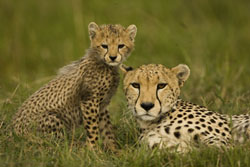
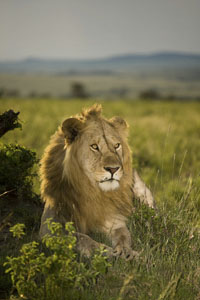
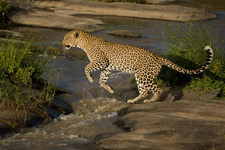
Day One - Nairobi to Samburu - Left relatively early,
around 9AM, but still didn't arrive into Samburu until around
5:45-6PM, uneventful ride that most enjoyed for the scenery and
culture.
Day Two - Samburu
AM - It rained much of the night, from around 2AM until around
6AM, but as we sorted beanbags and packed the vehicle the rain
stopped and we were able to open the roof hatches immediately.
Good morning, with baboons and babies riding jockey-style, vervets,
dik-diks, a wonderful superb starling, and a new born oryx with
its umbilical cord still hanging. The mother was being courted
- her back end was still matted from the blood of birth, and a
male repeatedly, over an hour's time, tried mounting her, but
without success. Oryx mating sequence - highlight.
PM - It looked like it would rain but as the game drive progressed
the skies cleared and we had sweet golden, angular light for much
of the drive. Had a great sequence with a trio of dik-diks at
a dung midden where they scraped, urinated, and defecated at the
midden, and scent marked with their preorbital glands. In our
last light I spotted a long-crested eagle that was very tame,
permitting full frame portraits. Highlight - the dik-dik territorial
behaviors.
Day Three - Samburu
The clear skies of last evening held, and today dawned bright
and, appropriately, we left the lodge only a few minutes after
loading, around 6:02AM. Crossed the Usaso Nyiro River to the Buffalo
Springs side, and headed into the high country where we encountered
a family of two Grevy's zebra mares and two foals of about the
same age - half year old or so. Encountered another group of Beisa
oryx, and the young males sparred and trotted, often in a high-stepping
ceremonial-like gait, for several minutes before finally settling
back to graze. Later, we worked a pair of reticulated giraffes
that were necking, often rather violently, and we could clearly
hear the pounding when a heavy head impacted upon the other's
flank. After several minutes dominance apparently was achieved
and the two wandered off. Had another great encounter with a large
male giraffe that fed, head-shot filling distance, from the track.
The mornings highlight occurred back at the river when we spied
a herd of elephants as they approached the river shore, and then
began a very noisy, very splashy crossing. We shot from a slight
angle, but David, our guide, thought there was another vantage
that was more direct, and Doug and Chris agree it was worth checking.
We found it, and were treated to a great head-on view of the elephants
charging across the river. Afterwards, several rubbed their necks
upon a skin-polished ancient tree, making great portraits. We
had seen a couple of other herds down river so we headed in that
direction, finding as many as 100 elephants along the shoreline.
A lone cow on our side started bellowing loudly, answered by others
on the opposite shore, and soon the herd of thirty cows and calves
charged across the river, answering her summons. It was a spectacular
display.
Multiple young males, and a few mature bulls, sparred along the
shoreline and in the river, giving us plenty of action and some
of the best river shooting we've had in a while. A pair of red
and yellow barbets surfaced from such roadside brush and began
their melodious duet before flying off, topping off our river
shooting.
Birds were fairly productive as well, with kori bustards, golden
pipets, and a pale chanting goshawk that unsuccessfully hunted
a lizard or snake not far from the track. We examined a five-year
old leopard tortoise, aged by its scute rings, and completely
unfazed by our presence, and Chris videoed a strikingly patterned
savannah monitor as it entered and swam through a small pool.
Arrived back at the lodge at 11:50AM.
PM A good but somewhat frustrating afternoon, as we had a first
that could have truly been the highlight of the entire trip, and
I'll emphasize 'could have…'
Started with a large troop of baboons and babies, but we were
somewhat out of position most of the time. Another vehicle, at
one point, blocked our path as they shot bad back and side lighting
of the baboons, in far too contrasty conditions, while ahead of
them, had they looked, there was wonderful, easy light. A short
time later, right at roadside, we had a very young elephant with
its mother, and a few minutes later, another mother/baby pair.
Good common agama lizard male on a tree, laughing dove perched,
and an interesting observation of a crocodile/spur winged plover
interaction.
We headed further down river looking for leopards, but three tourist
vehicles were stopped in the roadway with a indistinct shape in
front of them. It was a caracal, only twenty yards away from the
nearest vehicle, and it calmly drank water, paused, looked about,
and eventually walked, not slunked, off the roadway. It was so
frustrating to be the fourth vehicle in line, behind vans that
probably had no idea how rare and treasured this sighting was.
John, Kathy, and I shot the cat on the road, but the images are
small. Had we been closer, we would have had fantastic frame-filling
shots
We waited, along with our other vehicles, for the cat to reappear
but it stayed hidden. After ten-fifteen minutes we headed downriver
looking for leopards, but the rest of the late drive was unproductive.
Day 4 Samburu
AM - Another clear dawn, as we started out of the lodge a full
moon rested, half-concealed, against a low western cloudbank,
the only clouds we'd see until late morning. The day started slow,
for the first 15 minutes or so, as we shot a gerenuk resting and
backlighted, and several black-capped social weavers flying up
to their Christmas tree ornament nests, backlighted and glowing
in the early light. We did a race to some greater kudu but aside
from a brief, perfunctory view, they offered no shots. We had
a great African ground squirrel which can be skittish, but the
rare individual can be very cooperative, and this one was. After
we backed into position, getting as close as the track allowed,
the squirrel, as predicted, stood up prairiedog-like, then proceeded
to groom, grabbing foot or tail and enthusiastically combing through
its fur, drawing chuckles from all of us.
Along the riverine forest we had a very tame savannah monitor
that crossed our track and proceeded, just feet away, to sniff
out beetles buried in the soil, flicking its long blue tongue
like a divining stick and then nosing in, muzzling its self until
it came up with a large round beetle - probably a dung beetle.
We had multiple opportunities to shoot the monitor, most within
headshot range of our 500mm lenses. A Wahlberg Eagle distracted
us for a few minutes, but we returned to the monitor for more
shots.
Alex had missed the elephants at the river yesterday, but we had
a small crossing again today, with a small baby that flopped down
repeatedly once it made it across to our side of the river. Later,
we framed several elephants and small herds with doum palms and
Ol'lolokwe mountain, with the herd moving within feet of our vehicle.
As it was very hot we started back to camp, driving through the
forests en route, and stopped at one point by two small elephant
babies that walked in tandem beside us.
Several participants went to a Samburu village in the late morning,
and on their way back encountered a female elephant that had given
birth just moments earlier. The baby was still wobbly and on its
knees, but eventually gained its feet - without mom's help. As
they pulled out to leave, the mother unexpectedly released her
afterbirth in a gushing plop, stopping them in their tracks. They
watched as she dug a hole, scooped the afterbirth into it, and
proceeded to cover the tissue with sand and soil, knocking out
any tell-tale scent that might attract predators.
PM - Storms and heavy rained darkened the southeastern horizon,
but the weather continued eastward and missed us, and the afternoon
light was good. We were planning on following the riverine forest
to look for leopard or the caracal, and the birds common there,
but Henry, one of our guides, called that they had a cheetah report
and we headed there. Although tourism is supposedly down, from
the troubles of January and February, you wouldn't know it, and
there were about thirty vehicles circling where the cats had last
been seen. Two overland vehicles with European drivers broke all
the rules, driving off road to pass other vans and then getting
out of their vehicle to stand on the roof, looking for the cats.
Doing so, the cats probably hunkered down. Eventually I couldn't
stand it any longer and had my guide drive us over where we had
a bit of a spat 'discussing' their behavior, but they did get
down and stayed off the vehicles' roofs. We eventually gave up
and headed on to other subjects, finding a little bee-eater nest
in the elevated berm of the main track, but as we waited for the
bird to return we received another radio call that the cheetahs
were visible and on the move. We headed back, eventually seeing
the cheetahs, but they were distant.
Henry's vehicle had great luck with the cheetahs, both when they
first spotted them and again at the very end of the day, but we
should see more, and better in the Mara.
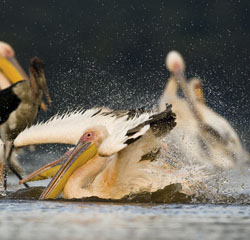
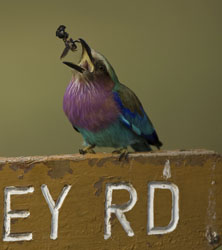
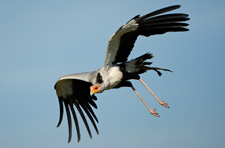
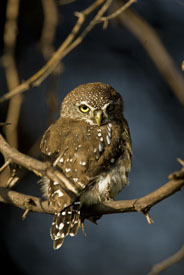 Day
5 Samburu to Nakuru
Day
5 Samburu to Nakuru
AM - Left the lodge at 6:30AM, late because of a billing error
with one of our participants, but we arrived in to Nakuru by 1PM,
greeted by rain. The first vehicle out of camp had a pair of lions,
male and female, walk down the road beside them, providing frame-filling
shots with the point-n-shoots everyone had ready. The real gear
was packed for the long morning of travel. Mid-morning we stopped
at the equator for touristy shots of everyone by the sign, and
continued onward. By mid-afternoon the rain stopped and the sun
shone, hopefully continuing to do so on the afternoon game drive.
PM - Nakuru - Overcast skies predominated, and our afternoon game
drive in Nakuru started with pleasant light. We were headed to
Cormorant Point for late afternoon flight shots of flamingos and
white pelicans, but we heard of a 'leopard' in a tree and quickly
switched plans. The cat turned out to be a rather large, fairly
good maned African lion male, about twenty feet up a sloping tree
and sleeping, much like a leopard except that its feet were tucked
beneath it, not dangling like a leopard often does. There was
quite a traffic jam and several times, as we got into position,
we had to move to let a large school bus load of kids go passed.
Eventually, however, we got into two great spots and had some
wonderful shots from two angles, including as the cat climbed
rather deftly down the sloping trunk.
The cat moved about, crossed the road, and eventually climbed
on to another fallen log about 5 feet off the ground. A van full
of American tourists were behind us, and a twenty-some year old
boy-child decided to attract the cat's attention by taking his
shirt off and waving it, bull-fighter like, around his head. I
saw the cat react and focus intently, and when I glanced back
I saw the kid waving his shirt. I quickly and vehemently put a
stop to that. Later, the same kid clapped and made noise to again
draw the cats attention, but we got his plates and Felix, one
of our guides, drove to the entrance gate to report him and the
van. Hopefully they'll be fined.
We headed to the Point but the light was so poor, and an advancing
storm looked so menacing, that we quit early so that the guides
could get some rest for tomorrow's long drive.
Day 6 - Nakuru to the Mara
Overcast skies that eventually burnt off to provide good light.
We started with Defassa waterbucks near roadside, then a spectacular
white rhino and half-grown male calf, the former sporting one
of the longest horns I've seen on a rhino. We followed that with
a great black rhino near the flamingo-lined lake shore, with the
rhino first giving us back views but finally turning and settling
down onto a bank, fully facing us. After shooting full-body shots
we moved in closer to do frame-filling vertical headshots, finally
leaving the rhino, resting, and at peace.
Nakuru had a good concentration of flamingos and we did fairly
well with birds coming close, and with undulating flocks of white
pelicans that passed by. A lone African buffalo stood in the shallows,
framed in the background by thousands of flamingos. Having limited
time here, we raced through the backcountry looking for the last
endemic we hoped to film here - Rothschild giraffes, and we found
five that proved very cooperative.
We transferred gear at the gate with Mary switching with John
for our drive to the Mara, and several folks making some very
nice carving purchases at the gift shop at the gate. The ride
to the Mara was exhausting, and everyone commented upon how it
will be nice to forget about that drive tomorrow. Fortunately
we'll be flying out of the Mara, so this experience only happens
once.
The southeast gate where we enter the Mara has changed dramatically
over the years, and now qualifies as a small town with side streets
and hundreds of shanties. As we entered the park we saw several
herds of Maasai cattle grazing within sight of the road, with
close-cropped grasses either a product of a burn-off or of cattle,
and no game. Only after we put a mile or two between us and the
gate did elephant, hartebeest, and other animals appear, a sad
state of affairs showing how this wonderful park is mismanaged
and will eventually be ruined.
Day 7 Lower Mara
AM -We headed to our favorite 'kopje' area to look for lions and
were successful almost immediately. We found a lioness with what
we thought were three 6 week old cubs, but ultimately five, resting
under a bush. The mother was unconcerned, but we had very limited
shooting windows in our first encounter. Another lioness with
three 6-7 months old cubs climbed atop another kopje so we headed
there, and got some wonderful shots of the mother and the cubs
drinking at a granite lined pool, filled from the rainwater of
last evening. When we headed back to the mother with the tiny
cubs we had more luck, as the cubs were out on an open bank of
a burrow they used for shelter - something we'd never seen before.
While we watched a third lioness came into view and grunted quietly,
driving the cubs into the burrow. A few seconds later she was
in the thicket with the first lioness and three of the cubs clambered
out to greet her. Mary's vehicle was in a great position to capture
the ensuing action as one or more of the cubs stood upright to
wrestle with the mother's head. After several minutes the cats
retreated a bit deeper into the brush and started nursing and
we headed off to the other lioness, who had now climbed on to
another kopje with her three cubs. There we got some wonderful
portraits of one of the cubs.
We had several lines of gnus moving northward, making us think
that the migration had reversed its southward route to the Serengeti
and was returning to the Mara. Yesterday afternoon much of the
Mara was under rain and, at 3PM, storm clouds, rain, and lightning
bracket our lodge in the East and West.
PM - Lower Mara
Before the game drive Bill K and I filmed birds in the courtyard,
a very cooperative African hoopoe and two little bee-eaters. I
got very close to the bee-eaters and used flash, as the light,
with an impending storm in the east, cut down the light drastically.
We left at 3:30 with the vehicles' roof hatches closed because
of the threat of rain but we opened them as soon as we cleared
camp and, while the weather looked threatening, we enjoyed great
weather throughout the afternoon. Mary's vehicle spotted a tame
serval before it wandered off, and we had three young lionesses
that were trying to feed on a zebra carcass (killed yesterday)
that safari ants had discovered. On a gut pile next to the road
the ants swarmed by the thousands, creating a patchwork of black
that everyone overlooked as ants until it was pointed out. The
ants had also found the carcass and we saw the lionesses jump
back several times as they tried feeding and ended up being stung.
We had a good roller and then David spotted a lioness about 1.5
miles away. I glassed the area with my 20X and spotted at least
three cats, and 15 minutes later we arrived at another zebra kill,
a foal, with five lions - 3 cubs, 2 lionesses. En route we passed
two others that were sleeping. We did some shooting and headed
back toward camp, encountering 3 male lions that were harassing,
unsuccessfully, a hippo far from water. As we watched the hippo
grazed itself back into the brush. Next, two hyenas, and then
I spotted a leopard in a tree over a luggage. David did a great
job of getting us into some sort of position, and Chris and Doug
filmed the cat as it came down the tree backward. We arrived back
in camp later than usual.
Day 8 - Lower Mara
Today 5 participants, Becky, Sherry, Doug, Chris, and Bill did
a balloon ride and the weather cooperated wonderfully, dawning
with a fairly clear east sky and, more importantly, no wind. Their
ride lasted an hour and forty minutes, terminating with a soft
landing where the basket they used stayed upright.
The rest of us game-drove back to the kopje area where we found
what we presumed was the mother with tiny cubs returning from
over a hillside, and most of the rest of the pride at a lion kill
from last night. Three well satiated, full-maned male lions were
in attendance, but they had finished eating and offered only portraits.
Another lioness, not at the kill, was headed in the same direction
an advancing group of zebra were marching, and we spent time with
them hoping for an ambush that didn't happen. Eventually one of
the lionesses, with her three 6 month old cubs, returned to the
kopje where she posed atop the highest rock. Two hours later when
we returned she was still there, draped and sacked out like a
neglected trophy.
In all we had 21 lions in the area, and good herds of zebra and
gnus near the Sand River where we had a dry river crossing as
zebras and gnus raced down the slope and galloped across the flats.
We had some secretary birds and a colorful flat-headed agama lizard,
returning at 11:30AM as the eastern skies darkened with looming
storms. By 2 much of the East is obscured by sheets of rain and
a gusting wind has dropped the temperature almost uncomfortably
cool. We're planning on a 4PM game-drive.
Day 9 - Lower Mara to Mara Triangle
We packed up and headed out by around 6:20, doing a game drive
en route to our next destination. Because of the rains we decided
to head to our usual afternoon location, Sopa, where the game
was fairly plentiful. The morning was somewhat uneventful, although
we did well, in good light, with the ostrich babies of the previous
evening, and we were outraged and depressed at the huge herds
of Maasai cows that were feeding deep in the southern part of
the park. Henry, one of our guides, had already started across
the kopje areas on the way to the Mara Bridge when he discovered
that one of the lionesses with the 6 week old babies was lying
atop a kopje, with two babies nursing and playing with her. All
of us got the radio call and we got there for some great shooting
- perhaps the best, most open we have ever had, since the lioness
was atop a rock without any screening vegetation.
In the afternoon we played chase with an incredible rain storm
that swamped the Paradise area and the Mara Bridge locations,
while we drove ahead of the storm to keep out of the rain and
in good light. Several vehicles went for two magnificent yellow-maned
lions but Kathy, Becky and I decided to pass on lions and try
shooting scenics with the tornado-like storm clouds. We did quite
well, shooting impala and zebras with clouds, while David, our
guide, spotted a huge black-maned lion in a boulder field. Those
locations are often almost impossible to get to, but David snaked
around and we got there right before the rains finally caught
us. As the rains intensified two other vehicles joined us and
we headed back to camp, concerned that we wouldn't be lost in
a descending fog or trapped in the tar-like black cotton soil.
Mary did well with the yellow-maned lions and got a great series
of shots of elephants silhouetted against the stormy sky and also
lost in the torrential rain.

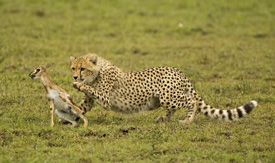
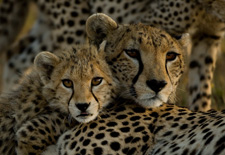
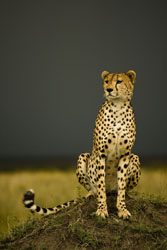
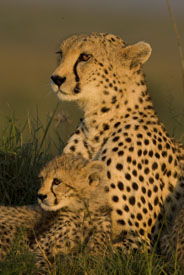
Day 10 - Mara Triangle
The day started very dreary, as if the storms of yesterday evening
never left. I was relieved to find my GPS unit in our vehicle
(I had thought I lost it), and the GPS would play an ironic role
in the morning's events.
We headed toward the Mara Bridge area to look for three cheetahs
working the area. In route we encountered a male lion with kill-grime
slimed across its mouth, making a profile of the cat appear as
if its jaws were twice as long as normal. A short while later
we spotted five lionesses that were returning from a kill but
walked close by a herd of gnus, and the juxtaposition of walking
lions and running gnus made great shots. For the first time I
saw hyenas mating, or trying to, as the genitalia of the female
makes normal copulation difficult and the male's success certainly
verified that. Still, we had several attempts, and it was interesting
to watch. We wandered widely looking for the cheetahs and one
of our vehicles eventually found them - rather close to the 5
lionesses, but the cats were lying in deep grass and doing very,
very little. All of us gathered there and ate breakfast, waiting
for the cats to get up and move. They did not.
En route, as we raced to the cheetahs in response to the radio
call, we had passed a herd of zebras where a few males were fighting,
but stopped as we drove by, and a female that looked as if she
were about to give birth. After breakfast, and driving by the
cheetahs for some headshots for Doug and Chris, we headed back
to the zebras, hoping to find a birthing zebra or fighting males.
We had some pretty good luck with the latter, but eventually that
activity died down and we decided to head back to the cheetahs
for a final look before heading to lunch. Mary, the last vehicle
on 'cheetah watch', had just departed, and informed me that the
cats were still down and doing nothing. We went anyway, since
Doug and Chris didn't have much of an opportunity with the cats
because of the zebras.
When we got there, the cats were still bedded down, but a herd
of gnus wandered into view and all three cats sat up to look.
I got out my GPS to give a waypoint, but to do so I had to detach
the anchoring strap to the vehicle. I made my mark just as one
of the cats posed nicely, so I started shooting. The cats moved
towards the open, low grass area and we followed, hoping to finally
get some shots of the cheetah's legs. Just as they reached the
grass I noticed that my GPS was no longer on the roof - it had
slid off into the tall grass! To my guys credit, they were fine
with me doubling back to try to find my GPS unit in the grass,
as we hoped to follow our tracks to recover it. We were not successful,
and circled repeated, making new, confusing trails, and drawing
a warden over who suggested we give up the search. Somehow, as
we drove a final track I spotted the GPS, directly in front of
our wheel. David stopped, and I retrieved the unit.
Because of this, we headed back to the cheetahs so my guys could
get the 'leg shots' they missed because of my lost GPS. The cats
had moved on, and were now apparently stalking the entire herd
of gnus. Doing something I'd never seen before, the cats ran into
the herd, which milled about in swirls encircling the cheetahs,
running in circles before finally moving off, leaving the cats
sitting or lying down where the herd had been. Now that the hunt
was over we drove in for some shots before heading back to join
the others in time for lunch.
Two Thompson's gazelles walked in to view and we thought we would
have another hunt but all three cheetahs acted disinterested,
moving about and revealing their location. The gazelles snorted
and ran off, but a short time later reappeared in view. While
we waited the cats rolled, walked, and finally began to play,
chasing and wrestling one another but at a distance too far for
any good shots. The gazelles, of course, ran off again. We moved
in closer to catch some of the wrestling and as we did so one
of the young cheetahs flushed a baby Tommie, which ran parallel
to us and then straight at us. The cats knocked it down several
times in play, lying beside the tiring baby until the baby either
panicked again and ran, or one of the cubs nudged it into action.
Eventually the cats let the baby run too far and the mother joined
in, quickly knocking it down and putting a serious enough hold
on the baby that all play time was finished. Still, the babies
grabbed the baby from the mother and for several minutes one or
the other would carry the dangling fawn until, finally, the mother
joined in and seriously began feeding. We pulled in for some close-ups
before heading back to the lodge for a very late lunch where Mary
joined us and we told our story, and I confessed to almost really
losing my GPS unit that started this whole sequence of events.
PM -The skies looked promising and, as the afternoon game drive
progressed, the weather turned wonderful, with spectacular cumulous
clouds and nice, directional light until the magic few minutes
before sunset, when a cloud dulled the orange light. Chuck and
I did some nice acacia silhouettes against these clouds, and all
of us tried to get to a black rhino, possibly with its calf, that
we spotted a mile or more away, but the heavy rains of yesterday
made travel impossible in the low wet spots. We spun out several
times, and screeched to a halt more than once as we headed towards
a wet soggy marsh.
We spent unproductive time at a black-backed jackal den - the
adults ran off and the five pups retreated to a hole, and despite
the busy road nearby they stayed shy, remaining in the den. Later,
in the last light of the day we stopped for another pair of jackals,
no doubt returning to another den, each carrying half of a Tommie
baby in their jaws. I jacked up the ISO to 1000, panned, and,
at least on the screen, it looks like I got something.
Day 11 - Mara Triangle to Upper Mara
Another gloomy morning, with low clouds and, just moments after
sunrise, a thin strip of clear sky yielding a faint Martian crimson
cast to the landscape that lasted too briefly and was probably
unseen by most. We headed toward the black rhino and calf we'd
seen the evening previous and were successful, and the rhino and
half-grown calf were very cooperative. At one point toward the
end of the shoot the mother moved close, then charged the vehicle
but stopped short, just inches from the grill. She' d done this
previously, so I wasn't surprised that she did not make contact.
We had 15 lions in total, including three pairs attempting to
mate. Some of our group captured three matings, but we had only
one, a rather disappointing, nonviolent performance. To add irony,
a pair we'd been following earlier that did not mate finally did
so, within sight of us and the other lions, on top of the ridge
line, a distant silhouette.
The gnu herds were everywhere, moving in highway like lines north,
and south, as if there were two lanes of traffic separated by
hundreds of yards, or miles, of medial strip. The sight, with
black gnu dots scattered across the landscape, rivaled scenes
from the Serengeti, and everyone was impressed.
PM - Upper Mara
To date we'd seen only one leopard, a poor view in the lower Mara
that was witnessed by only half the group. We needed leopards,
and headed out with that goal. Fifteen minutes out we got a call
that a leopard had been spotted on the side of the river we'd
just crossed. We started to turn around but I spotted a nice hammerkop
which we filmed fishing, then resumed our chase. Alex spotted
the cat as it headed up hill - away from the river and the area
we'd probably have been looking - and we got ahead of the cat.
Several times it walked almost straight to us, and by its size
I thought it was one of the cubs we'd heard about. It wasn't,
it was the female with two cubs!
She continued moving through the bush and it appeared as if she
was on a mission, and David, our guide, thought she was looking
for something, perhaps her cub. As she neared a very large termite
mound we raced into position, anticipating that she'd climb the
hill to continue her search, and she did. From there, over the
next fifteen minutes or so, she turned several times, surveying
the area and grunting low assembly calls. Once, perhaps frustrated,
she leaned over the termite mound and gave out a spectacular raspy
leopard cough, a series of coughing grunts, the first time Mary
or I had ever seen a leopard do this, and, in truth, we'd only
heard it a dozen times or so.
Eventually the calling worked and one of her two cubs, an older
female, appeared, calling as it slunk from one brush of cover
to another. When it got to the foot of the termite mound, however,
the young leopard darted up and joined its mother, in a slinky,
sinuous series of greetings that included sitting atop the mother's
head, head-butting, intertwining, and such general posturing that
it reminded me of a leopard, or any cat, going into heat. After
another fifteen minutes or so the two dropped off the mound, giving
us a couple of shooting opportunities before finally disappearing
into the heavy brush. At that point, with heavy clouds in the
west and low light, I called it a day, leaving early, but confident
we could not possibly do better, and anything else this evening
would be a time waster and anticlimax.
Day 12 - Upper Mara
Dreary, overcast skies and low light started the day, as we discovered
nine lions, 5 cubs, 4 lionesses, at a dual zebra kill. The cubs
played around the carcass and had a chase-tag session with a whole
liver that, strangely, wasn't eaten. We needed high ISOs to stop
action, shooting most of the activity at 800.
We found one of the cheetah mothers with cubs about 6 weeks old
but they were off track and distant. We spent a little time with
them before heading back to the lion kill, although one vehicle,
with Doug, Chris, and Alex, stayed with the cheetahs most of the
morning, getting distant behavioral shots.
AT the lions we heard of a mating pair that were quite active,
and while we waited the one hour the cats mated three times, about
every twenty minutes. As all the lions have done, these cats barely
walked anywhere, but instead just got up, sat down, and mated,
rather peacefully.
John, Sherry and I headed to the river to look for birds and leopards,
and had fair luck with bee-eaters and mousebirds. Becky, Chuck,
and Barabara's vehicle encountered a black-chested snake eagle
in the process of killing what we presume was a black spitting
cobra, at only ten yards or so away! The bird flared with its
wings to distract the bird, and used both its talons and beak
to kill it, the whole event lasting about 10 minutes.
Mary alerted us to a dramatic gnu river crossing at the double-dip
area. She had had one earlier, but thought another was about to
develop and called us in. While there wasn't much water, the shots
of gnus and zebras running or sliding down the mud chutes was
very impressive, making it the morning game-drives highlight for
us.
PM - Concerned about the rangers monitoring the cheetahs, and
the compromised photography that would result, we searched for
leopards again. The afternoon started bright, with distant clouds
that might, or might not, hold weather. The first part of our
game drive involved birds - baby and adult Egyptian geese, hadada
ibis, goliath heron, yellow-billed stork, another hammerkop in
rapids, and a flushed Mozambique nightjar that we assumed would
stay still but did not, but when its chick flushed, the chick,
a short-tailed version of the adult, stayed put. This is only
the third or fourth time I've filmed this bird - generally, if
you can see it you can shoot it, but this adult was, perhaps,
spooked by almost being hit by our vehicle. I only saw it as it
flew.
One of our vehicles spotted a serval and it was tame. David drove
ahead to get us into a great short grass position but just as
the cat appeared it spooked out an African hare, that ran by and
scared the heck out of the serval! It ran off, but resumed hunting
and we drove up again. We could see it struggling with something
- it had captured a green snake, probably an African green night
adder, from the looks of the scales I could see.
The cat moved off and we sought another position when Henry radioed
that they had great cheetahs - three brothers at a termite mound.
We sped to the scene, discovering three cats lying about the mound,
with one on top and facing us. However, the afternoon weather
had changed, and to the north a looming gray-black storm was advancing
and Bill B, seeing this, said 'let's get that cloud in the picture!,
which I had planned on doing but it was great to hear a participant
recognize that the shot wasn't the obvious - the three cats facing
us. We drove around the termite mound, with the cheetah on top
facing away from us, but soon it turned our way, then rolled in
our direction, and finally sat up, facing us straight-on, with
the black cloud behind it. It stayed for quite awhile, finally
being bumped off by one of its brothers, who did the same pose.
As the storm neared, and the advancing clouds of that front obscured
the sun, the light fell dramatically and the cats got active,
walking between the rows of cars to find shelter. We left them
then, deciding not to chase the cats and produce images that couldn't
possibly compete with the ones we'd just made. We arrived back
in camp at 6PM, the second night in a row that we arrived in early,
and very satisfied.
Day 13 - Upper Mara
Our last day afield, and once again the skies are gloomy and overcast,
making all the more remarkable the fact that the day our participants
did their balloon safari the skies were clear, the only day we
had those conditions at sunrise since we've entered the Mara.
We've had weather like this before, and these days reminded me
of some of our times in 'the old days' at Mara River Camp, but
back then we used film, and gloomy, dull dark days were impossible
for shooting. With digital, and an easy ISO of 800, that's no
longer a problem. What has changed, however, is the overall weather.
In early September the area around Thompson's Falls, a highland
area we passed en route from Samburu to Nakuru, had approximately
10 inches of snow! Apparently a big storm, and a mix of hail and
snow combined to lay down a blanket of ice and snow that lasted
for several days. If true, this has not happened within anyone's
memory - a pretty significant event indeed.
While it still seemed very dark we got a radio call that there
was a serval spotted, and as we drove up the half-grown cat, really
a kitten, huddled by the side of the road. It got up, walked through
the grasses and finally sat on its haunches, offering numerous,
very good opportunities for portraits. In all, three servals were
spotted today, including one Mary saw at a distance while we were
all shooting cheetahs that remained in the open, beneath a tree
for ten minutes or so. Earlier, in the grasses it had captured
a large rodent and Mary saw, through binoculars, as it played
with it by tossing the rat into the air. A tempting subject to
be sure, but we were involved with other things …
We were told of another cheetah nearby so we headed there, where
we shot it in the open before the apparently nursing female got
up and walked over the hill. David suggested we not follow it
so we continued on, and soon encountered another cheetah, this
one with a fresh kill, and the three 6 week old babies we'd seen
yesterday. The kill was in some medium height grasses close to
the track, and around one side the grasses were short, forming
a perfect arena as a play area for the cubs.
Over the next three hours we sat and shot the three cubs as they
raced, wrestled, fed, and played with mom. The cubs were fearless
and ran beneath our vehicles constantly, and often climbed on
top of a tire where only a few feet separated the oblivious, playful
cubs from a delighted tourist leaning out of their vehicle with
a point and shoot. Everyone was in danger of running out of gigs,
as the shooting was extraordinary, marred, perhaps, only by the
low light - most of the shooting was at ISO 800, and rarely at
400.
After the cheetahs started moving we followed for a short time,
but the cats seemed intent upon finding shelter and, in truth,
the best shooting was over. We headed toward the Talek River where
we encountered the same lion pair as yesterday, still mating,
or attempting to. The female got up several times, the male followed,
but each time the lioness just flopped to her side and snarled
and growled when the male made further advances.
Mary radioed that more gnus were crossing at the double-crossing
lugga, but by the time we got there the two thousand or so gnus
we saw were finished. It occurred at the same location as yesterday's,
but because of last night's rain what was an ankle-height stream
was now so deep that the gnus had to swim across. Mary reported
that it was one of the most dramatic crossings she'd ever seen,
as gnus plummeted down the steep bank, headfirst and sometimes
backward, as well as frequently leaping into the stream. She finished
all of her cards here.
PM - Our last game of our first safari, and although the pre-game
drive skies looked threatening all the weather worked around us
and it was clear. We spotted the lone female cheetah almost immediately,
but she was still sleepy and bloated from a kill. A short time
later we found the mother cheetah with three cubs, sitting on
a low, grassy termite mound. One of our vehicles, and another,
were already there and a bit closer than I'd have liked, so framing
with a 500 ended up to be rather tight portraiture. Still, we
got some nice interaction between the mother and cubs before they
started wandering, perhaps for an evening shelter. We followed
for a few minutes but the best shooting had passed and we moved
on to help with a final, unsuccessful quest for a leopard. En
route we saw six more lions - all from this morning, but all were
sleeping. We had to remain on the camp side of the Talek river
because of the high water from the previous days rains, so, with
the leopards likely to be on the other side, and heavy storm clouds
blocking the late sun, we headed back for a 6PM return to break
down gear and pack, empty bean bags, and secure the vehicles with
the camera gear for the drive back to Nairobi.
An extremely successful safari.
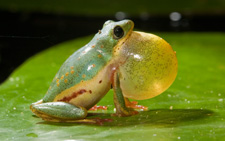
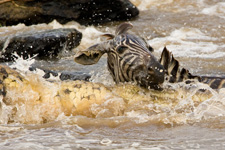
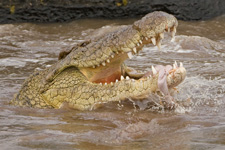
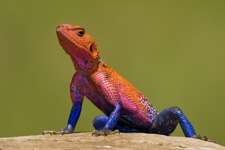
We had some of our best luck with herptiles
this season. A reed frog sings at our lodge at Lake Nakuru; a
Nile crocodile does its 'death roll' to tear off junks of meat
from a zebra (although it looks alive here, it had been drowned
earlier by the crocodile); a Nile crocodile gulping down meat;
a flat-headed Agama lizard.
Everyone arrived early in Nairobi, with their luggage, and although
we didn't formally meet as a group until the morning of our departure
Mary and I met everyone in the hours after our return from Rwanda.
Shortly after checking in to our hotel, the Nairobi Serena, I
had a first - as I took the elevator to our sixth floor room the
power went out. The elevator stopped and the lights went out,
and for a minute or so I was in complete darkness. When the power
returned the lights did, too, but the elevator was dead, and the
buttons operating the lift were useless. I hit the alarm button
several times, creating a siren-like whine, but didn't get a response.
I'd had a bit of an upset stomach early and now, in the increasing
heat of the trapped elevator, I felt some urges coming on, making
the situation a bit desperate. To escape the heat and the growing
internal pressure I laid down on the elevator floor where, with
minimal movement, I could periodically bound/tap on the metal
door with one foot. Finally I heard voices and a few minutes later
the door's were finally opened - on the sixth floor about a foot
higher than floor-level. The crew that opened the door laughed,
as it looked as if I had been sleeping, which, indeed, I almost
had. The rest of our pre-safari day went uneventfully.
Day 1 - Nairobi to Samburu
Since we had two vehicles with only two passengers Mary and I
took one so that we could drive ahead and make room arrangements.
The trip went uneventfully, although at Tree Trout, our lunch
stop, the colobus monkeys appeared for a brief show. The light
was rather contrasty so Mary nor I shot, although several of our
participants did and, from the angles I saw, they should have
done fairly well.
As we drove into Samburu we saw almost all the endemics - oryx,
gerenuk, giraffe, elephant, dik-dik, waterbuck, so the ride bode
well for a promising time here.
Day 2 - Samburu
AM - The morning alternated between clear skies and clouds, but
as the morning progressed the clustered cumulus clouds opened
enough to generate a humid, torrid atmosphere. I spent a good
portion of the morning working out the kinks of shooting and safely
stowing away equipment between drives, and coaching on some shots,
but we still managed some nice shooting of gray-headed kingfishers
and a nice elephant crossing. Most of our vehicles had luck with
elephants at the river and for most that was their highlight.
PM - Beautiful skies, with a hint of storm and plenty of cumulous
clouds, making the close-to-the-track elephant herd a wonderful
study in polarization. There were elephants everywhere, and I'd
guess we saw over hundred scattered across a relatively small
area, all busy thatching grass or low growth, the product of the
heavy rains Samburu has experienced the last few weeks.
Along the river a troop of vervet monkeys foraged too closely
to a pair of water dikkops, or thickknees, who splayed their wings
horizontally and downward, projecting their necks forward and
hissing as they tried, successfully, to keep the monkeys from
moving closer. Obviously they had a nest, and we soon spotted
the two eggs nestled quite close to the road and against a small
chunk of acacia, but quite out in the open. Typical of shorebirds
and plovers the eggs were spotted and dappled, but against the
red sand they were surprisingly conspicuous. Closeby, the etched
grooves of recent elephant tracks marked the sand and I wondered
how the birds handled that encounter. Elephants have been known
to trash ostrich nests, tossing the eggs about, but I suspect
a stalwart bird would intimidate an elephant enough to keep the
eggs from harm's way.
While we were waiting for the dikkop to return to the nest we
got a radio call that a leopard was spotted, resting in a tree.
We abandoned the dikkop and raced to the leopard, which slept
peacefully near the top of an acacia quite close to the track
and, not surprisingly, surrounded by vehicles track-side. There
wasn't a shot at first but eventually we moved up, as vehicles
lost interest in the sleeping leopard, and we were positioned
beside the tree in a perfect spot for a shot of its descent. And
then we waited.
Just after 6, and 25 minutes into our watch, the leopard stirred,
looking about and rearranging its paws. We did several flash exposures,
and, as the light fell, the flashes overcame the bright sky background
so that the cat had color against an otherwise gray sky. At 6:11
we had to leave, faced with a 6:30 deadline at the lodge, and
we broke down our gear. We pulled away and David, our guide, looked
back and saw the leopard descending! We raced back, tried to pull
the flashes out in time, but the leopard atypically zipped down
the tree and hopped to the ground before we got set. It crossed
the road and headed downhill to the river, giving us good looks
and reinforcing the lesson that patience pays. In this case, we
simply ran out of time.
Day 3 - Samburu
AM - The guides were ecstatic today, a day that changed history
according to them, for today, election day in the US, the Kenyan's
candidate, Barrack Obama, won the election for the presidency.
David received two calls, an election-central, from two US friends
informing him of the news, and I spoke to one of them, a former
participant on one of our trips. She was almost speechless, she
reported, and the guides beamed.
While this was going on we opened and closed our roof hatches
two or three times as repeated rain squalls, some quite heavy,
swept across the Buffalo Springs side of Samburu. After one, as
we opened the lids to the vehicle, the Samburu side was almost
lost in a wall of gray, sheets of rain that obscured the prominent
mountain ridges of that side. Slowly the weather broke and by
mid-morning it was again hot and humid.
Animals were active in the early coolness, and we had neck-sparring
reticulated giraffes, semi-serious fighting oryx, standing gerenuk,
calling yellow-necked spurfowl, and a variety of other birds.
The U-N river was high, and increased in flow as the day went
on. Mary may have had the coup' of the day, however, when a butterfly-like
golden pipit displayed before her. The golden pipet is a brilliantly
yellow bird marked by black chevrons and trim and, in flight,
its golden-yellow flight feathers flash so brilliantly it brings
to mind a flashing butterfly. Normally one sees these colors as
a bird flies off or flits across the low scrub but today one repeatedly
displayed from a perch, returning several times and giving Mary,
Betsy, and Cindy the chance to shoot the bird as it launched,
and Mary, at least, caught one of the flights in sharp focus.
She was thrilled.
While yesterday was filled with elephants we saw only one today,
as the others apparently headed into the high country with the
rain. Throughout most of the night we had a gentle rain, sprinkled
at times with intermittent thunder storms, and the elephants,
now free from the river, headed out. Their absence, so abrupt
after just plenty the day before, was indeed dramatic but a welcome
rest to the elephant-damaged trees along the U-N river.
By 1PM another heavy rain rolled in and at times the river outside
our tent was invisible through the heavy sheets of rain. Thunder
rocked across the sky promising more rain through the afternoon
and a rather gloomy, damp, and dark PM game drive.
PM - It rained most of the afternoon but by 4PM the rain had stopped
and we conducted the game drive with open vehicles, beating the
rain as we headed in for a slightly earlier than usual return.
Throughout the afternoon the skies were overcast, which made for
great mammal light until the gloom grew so intense that, at 6,
it seemed that we were long past sunset.
Still, the shooting was good, and Cindy, Mark, and I spent a lot
of time early on several vervet monkeys with babies. The first
we spotted was grooming her baby when another, perhaps an older
sister of the infant, approached. I suggested they be ready for
some interaction, and within seconds the other monkey came in,
grabbed the baby, and, as if in a gesture of appeasement, began
grooming the rump of the female. Eventually the 'aunt' moved off
with the baby but within a minute the mother joined her, and after
a little fuss retrieved her baby. At another log we shot another
'aunt' with an infant, who again, after a spell, was joined by
the mother who took the baby and moved off.
I had the best golden-breasted starling opportunity ever, but
the bird was in that poor afternoon gloom and against the sky,
so the shots will be meaningless. The bird, however, was surprisingly
tame, perched in the open and singing for multiple frames. We
also had luck with white-crowned shrikes, hornbills, and superb
starlings, as well as a statue-like buck gerenuk. Two of our vans
were fairly close to the martial eagle adult we'd seen on our
first morning game drive, again with the continuously crying fledgling
nearby, and although the working distance looked close we didn't
bother stopping as the light was far too dim. Earlier, for at
least several shots, the light was adequate, and the martial eagle
feeding upon a dik-dik on a fallen tree just above van level was
the highlight of several shooters. Another of our vehicles, late
in the day, found three striped hyenas at a kill, and got pictures.
Day 4 - Samburu
For only the second time in over twenty years of doing safaris,
I missed a game drive. I hadn't been feeling great the last two
days, with no appetite and tiredness, perhaps brought on by a
marathon exercise session in Nairobi the day that we arrived back
from five days of gorilla trekking. My general diagnosis was a
glycogen-debt from the exercise, but regardless, my stomach was
upset and a dinner of pasta didn't help. Instead, a build-up of
gas made me feel as if I was going to explode, and, sparing the
details, I generally did so throughout an almost entirely sleepless
night. With two immodiums I was showing improvement but I didn't
want to risk compromising a game drive, and, in truth, I'd have
been a poor asset. Mary, almost deprived of as much sleep as me,
headed out to a day that dawned dark and dreary but, by 8:30 or
so burned with a clear sun.
At lunch, as we did group highlights, I discovered that everyone
had a fairly productive morning, with great scenics, a yellow-billed
hornbill nest, a large group of elephants - returned from an absence
just yesterday, a female kudu - a real surprise, considering the
wet weather, as these animals only come to the river to drink
during the dry season, a huge herd of giraffes, with over 50,
and an equally large herd of Grevy's zebras.
PM - My insides were still doing an internal version of a violent
thunderstorm so I stayed behind, and as the game drive started
the skies are overcast and dull - good cat and mammal light. The
game drives started promising, with partly cloudy weather and,
with the threat of rain, the vehicles crossed to the Buffalo Springs
Reserve where everyone had tremendous success with olive baboons,
including many closeup mothers with babies. Mary felt she did
her best baby baboons ever, and these terrestrial primates were
the highlight for most everyone. Mark and Cindy shot a great late-light
scene of a trio of acacias illuminated by a golden shaft that
sneaked through the western storm clouds momentarily, but when
that window closed the light went with it and everyone came in
around 6.
Day 5 - Samburu to Nakuru
At dinner and throughout the night it rained, often hard and frequently
accompanied by thunderstorms, and we wondered if the dry washes
and dry riverbed we must cross to leave Samburu would be open.
In the past, on some game drives when we had a previous night's
rain these routes were closed, requiring us to return to camp
to wait and hour or two until the flood waters dumped into the
U-N river and cleared the washes. Once, about three years ago,
we were staying in a tent that was situated close to the river's
edge and while we were on our morning game drive we got word,
via radio, that our tent was being evacuated because of high water.
A wall of raging water creating waves and rapids over 6 feet high
were roiling the U-N, so fast that water was literally backing
up and creeping into dry washes backwards, literally moving upstream.
The flood was caused by heavy rains towards Thompson's Falls and
the highlands, and/or rain in the Aberdares where, because of
deforestation, heavy rains no longer held but instead raced downward,
wrecking havoc as they did so. All of our luggage was moved, except
our computers and hard drives which were still on our desk, and
when I discovered that … I wasn't happy. When we returned
to camp we found that the water was only inches below the deck
on which our permanent tent was set, and the dining room of the
lodge was now an island of pylons, with the water lapping just
feet below us. As it turned out the pylons and posts holding up
our tent survived, the water receded, and we moved back into our
tent. That night, however, it rained heavily again and the waters
rose, and fearing that we might find ourselves marooned at our
tent at dawn, and perhaps facing even higher water or the possibility
that the tent platform itself could collapse in the river, we
evacuated ourselves in the middle of the night, walking through
now ankle-high water to reach reception. Fortunately the waters
didn't rise as high, but after that almost sleepless night we
decided to use another tent in the future. Thus last night's rain,
although worrisome, wasn't as critical as it could have been and
we did sleep.
By dawn it had stopped raining and although heavy clouds lay to
the east, Mt. Kenya was visible from Samburu, and appeared to
be sheathed in a fresh blanket of snow. The ride to Nakuru went
smoothly, and despite the rains we had, much of the road to Isiolo
was dry, as if the storms missed that area entirely. We arrived
in to Nakuru by 1, with promising western skies and, in the east,
a black wall of rain that may envelope the lake or pass on by.
PM -Although storm clouds and a dark wall of rain obscured the
eastern shore of Lake Nakuru the skies looked promising for an
afternoon shoot, and the 4PM game drive started sunny. We headed
to Cormorant Corner, hoping to film African white pelicans as
they sailed in on decurved wings to bath in the freshwater stream
that empties into the lake here. Much of the sky was covered with
dark clouds, so the sunlight striking the numerous lesser flamingos
lining the shoreline here made the multitudes glow. A few pelicans
bathed in the stream, and a trio of pied kingfishers perched on
some snags - two taking a moment for a brief mating that Cindy
and Betsy captured, while near lake shore yellow-billed storks,
stilts, various shorebirds, and, as a first-ever, several African
skimmers, birds unique in having a lower bill longer than the
upper which they use to cut the water's surface as they quite
literally skim the water. When a small fish or invertebrate is
snagged, the bird jerks its head downward quickly, trapping the
bird between both bills. Skimmers are found throughout the world
- recently I filmed a small colony on a river in the Pantanal
of Brazil, and my photo career started in my late high school
days with long-term filming of the American version, the black
skimmer.
Unfortunately the birds were not very active, and although we
had a short time where true sunlight bathed the pelicans in a
soft gold light, the shooting was slow. Soon, too, the light disappeared
and grew increasingly worse, as that eastern storm slowly crept
along the shoreline to eventually envelope us as well. As the
first drops fell, we picked out a spotted hyena hunting the shallows,
intent on picking off an injured flamingo, or scavenge a dead
one. This was the first time I'd seen a hyena work the shallows,
and despite the bad light (or perhaps because of it the hyena
was active) we hoped that it would charge the flamingos in an
aggressive hunt. It did not, but simply loped along the shallows
while distant birds ran off into deeper water. Presumably the
hyena can spot a potential victim and would then divert, but tonight,
as we drove in reverse to keep pace, the hyena apparently saw
nothing of interest. As the light failed and heavier drops started
peppering the landrover we packed up and headed back to the lodge,
arriving early, at around 5:20PM, in a very dull, gloomy early
dusk.
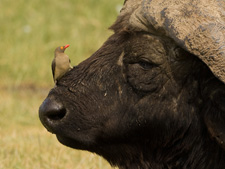
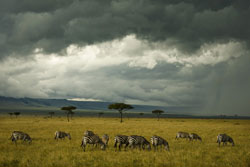
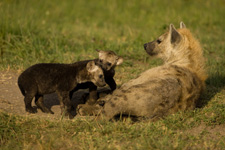
Day 6 - Nakuru
AM - One of a chain of soda or alkaline lakes strung along the
eastern edge of the Rift Valley, Lake Nakuru makes and excellent
half-way point between Samburu and the Mara. Famous for its flamingos,
which generally feed here in huge numbers, Nakuru is also quite
noteworthy for its white and black rhinos, both introduced into
the park and well-protected. This morning, as expected, we saw
all three.
At breakfast we bumped into another photographer and his wife
who are basically following our path and our itinerary but who
are self-driving. Yesterday, they too left Samburu, but with a
flat tire, and one wrong turn, they didn't arrive into Nakuru
until 11PM. After dark their progress was slow, as dark people
in dark clothes crossing unlit streets, and, even worse, bicyclists
without lights, made their travel slow, nerve-wracking, and exhausting.
We felt poorly for them and wondered what adventures the Mara
will bring, where vastness, a complex of signless roads, wet marshland,
and vehicle-trapping black-cotton soil could easily lead to disasters.
Yesterday, as we traveled to Nakuru the entire Rift was enshrouded
with clouds, and the park itself saw rain throughout the morning.
Today, we were lucky, and although the day started with the normal
overcast, typical for here, it quickly burned off and we had a
sunny morning with wonderful cumulous clouds that may herald afternoon
rains or storms.
Flamingos were in, and we saw more greater flamingos than usual.
Greater flamingos are not only larger than the more common lesser
flamingo, they are also much brighter white. Adults lesser have
varying shades of pink, ranging from a light wash to almost a
rose red, and a decurved bill that appears dark at a distance.
Greater flamingos look white, and their vivid bi-colored bill
and bright pink legs are diagnostic.
We saw many rhinos, mostly whites, but one black rhino that Debbie
and Mike had quite close, and that cooperated by crossing the
road in front of them. While black rhinos do indeed look darker
- generally a slate-grayish black, white rhinos are also very
gray and, in color, look very similar. The name, white rhino,
is actually a corruption of the Africaans name for the rhino,
'weit' which means 'wide' and refers to their wide, grass-chomping
mouth. Black rhinos, in contrast, have a triangularly shaped mouth,
a finger-like lip that is used for browsing. From a distance,
the grazing white rhino is usually easily distinguished by having
a huge head and neck that turns rather abruptly downward, and
in having two scalloped hollows to its back. The black rhino,
in contrast, has a roundish back, a slightly smaller head, and
a posture that usually has the head held high, at least to the
level of its back. Color itself is meaningless.
We spent much of the late morning alternating between a group
of resting white rhinos and a large, sitting collection of white
pelicans that were nearby. Periodically squadrons of whites would
coming sailing in from nowhere, suddenly appearing as vivid black
crosses in the clouds before spiraling down to join the flock.
I tried some slow pans of the flamingos in the lake to create
streaks where, in PS later, I'll try some composites that might
depict motion in an interesting way.
PM - Eastern storm clouds dissuaded all but four from going out
on the afternoon game drive. Mary and I had decided, regardless
of the weather, to sit out and take a break, but as folks gathered
for the drive, and saw the weather, most decided their time would
be more prudently spent resting or editing images.
As it was, of the two vehicles that went out, one returned in
thirty minutes and the other in forty, as the storm overtook them
just as they left the lodge and, between increasing rains and
darkening skies, there wasn't much of a reason to be out. Mary
and I edited, and I discovered that my slow pans for the flamingos
weren't too effective, so that PS work won't need to be done!
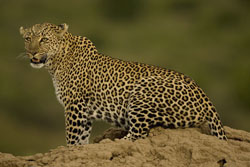 Day
7 - Nakuru to the Masai Mara
Day
7 - Nakuru to the Masai Mara
Last evenings weather lingered, and the skies were broody and
dark, and we were thankful that we'd spent the previous morning
devoted to bird photography at the lake, in sun. Today the birds
would have been dull, so we devoted our time in looking for the
one species we still hoped to find in Nakuru, the introduced Rothschild
Giraffes, transplanted in this protected park from western Kenya
and Uganda where, quite likely, they no longer exist in the wild.
In many ways the Rothschild resembles the Reticulated Giraffe,
but differs in having unmarked, white legs - stockings, as it
were, while the other two species have coloration extending down
past the knees. We were very luck and found two close to the road,
and, in the distance, nearly a dozen more that slowly moved in
our direction and fed on roadside vegetation close enough for
headshots.
Other vehicles had some luck with lilac-breasted rollers and rock
hyrax, but we weren't planning on spending the entire morning
in Nakuru because of the long commute to the Mara. Our need to
leave was encouraged by the weather, as rain settled in, requiring
us to close the roof hatches as we started driving out of the
park. Nakuru apparently has had a lot of rain, because fields
on either side of the road near Kenyatta's old residence were
flooded, and where in all the years I've never seen anything but
dry fields here. We passed a family of painted snipe quite close
to the road near a flooded channel - probably a worn game trail
- but as we pulled up our lenses the birds flew off.
At the gate we broke down our gear for travel, and spent nearly
an hour at a curio shop whose owners we've known for years. He
had just added a new store, a 'fixed price' gallery, and he wanted
Mary and I to officially open the store. It was fun - he had hired
an official photographer, had made a beautiful sign that not only
identified the shop but stated, 'Officially opened by Joe McDonald
and Mrs Mary Ann McDonald on November 9, 2008,' and we unlocked
the door and opened the store for our participants. The store
was nicely done and several people purchased some items, which
made everyone happy.
The drive to the Mara, 'though tedious, went uneventfully, except
at lunch one drove off to get both tires repaired. Whether that
could have been done elsewhere or not, we didn't know, but waiting
for him to return involved most of an hour. Still, luckily, we
got to our lodge by 5:30.
While unpacking our gear I set out a chest set that we'd purchased
earlier and, while my back was turned, a vervet monkey ran over
and removed one of the wrapped bags containing some of the pieces.
I didn't see it but one of the lodge staff did, and he asked me
if the monkey had stolen food. When I saw what the monkey had
stolen I was a bit annoyed, and tried to get someone moving to
get a ladder to retrieve the pieces, now in the hands of the monkey
on the roof of the lodge. I didn't get any progress there, but
as we watched the monkey wandered off, and it looked like it had
abandoned the package. I quickly circled the area, hoping that
the package had rolled to the ground but without luck, before
finding a tree I could climb that touched the roof where I could
scramble over and check things out for myself. It was pretty amusing
to watch, I guess, as I appeared on the crest of the roof carrying
the package. Fortunately I got down again without incident.
Day 8 - Lower Masai Mara
The day started clear, with a thin band of clouds just hugging
the eastern horizon, and we headed to the kopje area hoping to
find the lion cubs we'd encountered on our last trip. The abundant
rain had so sodden the ground that vehicle tracks were clearly
evident, marking that the cubs must still be in the area, and
within a few minutes we spotted two females and cubs. As we neared,
we discovered seven cubs, two more than last trip, and within
a short time a third lioness walked in and started grunting, calling
a pile of cubs towards her. The cubs and lionesses moved frequently,
giving us several opportunities for shooting, and eventually holed
up at the kopje they used most frequently three weeks ago.
The rest of the game drive was rather slow, with a few dozen zebras,
three warthogs, three topi, and large herds of buffaloes that,
from a distance, we mistook for gnus. This scarcity isn't necessarily
a bad thing for us, as few animals means that the predators must
hunt as the opportunity arises, and we might witness a day-time
hunt or kill. It is, however, a time of stress and uncertain futures
for the predators, especially the cubs, as the lionesses will
desert them if the need to find food requires them to travel widely.
Now knowing these cubs for four weeks, and seeing their progress
in the three weeks since we last were in the area, would indeed
be sad, but for the lionesses, the loss of cubs is not a huge
setback. In times of plenty the lionesses will again come into
heat and produce a new litter, and to maintain a stable lion population
only two cubs, of the several dozen a female might bear during
her lifetime, need survive.
PM - In the five weeks we've been in Kenya, this was perhaps the
clearest afternoon we've had, with no rain, and only clouds along
the western horizon that guaranteed that the last minutes of the
game drive would be in very dim light. The afternoon started somewhat
slowly as the plains near the lodge were devoid of game but the
further south we went the more animals appeared, so that, from
a hillside track we could see Thompson's gazelles, topi, hartebeest,
buffalo, giraffes, and elephants within the sweep of our binoculars.
A family of six jackals, 2 adults and 4 half-grown young, coursed
the grasslands unfazed by our vehicle. At one point one of the
adults sped off after a doe impala and her fawn, but whether it
gave up the chase as useless, or simply lost the quarry in high
grass, it was unsuccessful. The baby impala, now in short grass,
hopped along stotting, as if advertising its fitness and futility
of a chase.
We had a nice pair of crowned cranes, again unconcerned by us
as they stripped off seed heads or paused, lengthily, to groom.
Our afternoon concluded with 7 lionesses and half-grown cubs,
where a nearly emaciated cub snuggled up to a female to be licked
and gently wrestled. While lions have incredible recuperative
powers when starving, I guessed this one had less than ten days
if it didn't get to share in a meal.
Day 9 - Lower Masai Mara
Tom and Joan did the balloon trip this morning, which is always
a cause for some anxiety as the weather plays such a huge role
in a satisfying flight. Fortunately, the dawn was still, and the
mottled eastern horizon yielded one of the most spectacular sunrises
we've had so far this year. With the sun up, these low clouds
disappeared and the morning, for aerial scenics, was clear and
spectacular.
A family of ground hornbills were active shortly after we started
our game drive, flying to a large fig tree before gliding back
to earth where Mary and Graham did quite well as the birds captured
grasshoppers. Like all hornbills, these huge, turkey-sized birds
nest in cavities or tree holes, but unlike their smaller kin they
do not wall up their mate in a protective shell of mud. Tree cavities
large enough to accommodate such a large bird in a mixed grassland-forest
environment are understandably scarce, and no doubt because of
this hornbill families stay together, with the next generation
helping the adults to raise and feed the next generation. Accordingly,
it is not unusual, as we had today, to have four or more quite
adult-looking birds working together. It is thought that this
type of cooperative behavior may be rewarded by nest-cavity inheritance,
should the breeding adults expire during this time. How, and exactly
when, the next generation does decide to leave the territory,
and whether or not that's because they've encountered a potential
mate, are unanswered questions.
Surprisingly, we had a large male hippo that, though shy, fed
in the open long after sunrise. An half dozen yellow-billed oxpeckers
were latched upon its back and sides like leaches, and were probably
worrying wounds caused either by fights or rips and scratches
from acacias.
We encountered a nursery of baby giraffes, as did another of our
vehicles, and our youngest appeared to be less than a day old.
Its hind legs, instead of being straight, were cocked and canted
at almost a right angle to its hips, still folded from its long
gestation, but even as we watched the legs appeared to be straightening.
Another baby, perhaps two weeks old, strolled up and for several
minutes the two nuzzled heads, licking each other's face. When
the older started feeding, the newborn tried stealing grasses
from its mouth.
The mother was, in typical giraffe fashion, rather unattentive,
showing no maternal inclination other than letting the baby snuggle
in close. A large male moved in to investigate the female, smelling
her back end but without flehmen, and the baby walked over to
investigate. Remarkably, the male tolerated this, and sniffed
the baby, much like a mother might do, without ever showing aggression.
I expected the male to butt the baby away or to kick, but it did
neither.
Mary and Graham had great luck with three lions that were playing
together, in the open, for some very nice shots. They did exceptionally
well today, with two servals, a nice bat-eared fox, and the lions.
For the other vehicles the day was a bit less spectacular, although
filled with birds and wonderful scenics, and several of us saw
two Nubian vultures lock talons and spiral earthward before breaking
off and resuming flight. They did this several times, and attempted
this awkward maneuver several more. We also encountered a long-crested
eagle that we'd seen three weeks previously, 9 miles away at Mara
Intrepids. The bird was distinctive, with a broken secondary feather
on its right wing that jutted upwards, giving the appearance of
a broken wing. On that day it was with another, and the two, sitting
side-by-side, called continuously, with one pawing the other with
a raised foot which we thought would be a prelude to mating. Today,
the bird was alone.
Although we saw 18 lions in all, game was scarce, and in the absence
of wildebeest the plains look devoid of game. We saw one herd
of gnus of about forty, and several lone gnus - meals on wheels,
as Gary said, and one tiny, lost elephant that has a dubious future.
PM - We headed back down to the Sopa area where, yesterday evening,
we had a pretty successful afternoon. We were not to be disappointed.
Although stormy clouds surrounded the area, and periodically we
had sprinkles, the light was bright enough, and soft, to still
be quite usable for shooting. Shortly after the game drive started
Henry, one of the guides, spotted a Martial eagle that was on
a kill. When we arrived it was in the midst of plucking a large
white bird, and primaries, body feathers, and down were scattered
across the grasses. As our vehicles approached the eagle used
one foot to carry the bird a few feet, dragging it along with
a limping gate, and we spied the red bill of its prey, a European
white stork. It moved the bird two more times, and in doing so
presented itself for some very clear shots.
Further south, towards the area we call the Oasis, we came upon
10 more lions - two cubs and a lioness that were nearby, with
the different aged cubs playing continually but on the wrong side
of the female, and a mating pair that mated once while we were
there, a pretty good, somewhat violent act that only lacked the
female swatting the male at the conclusion.
While we were waiting for another mating one of our other vehicles
arrived, informing us that they had just seen a long-tailed pangolin,
although their message was a bit garbled - 'pangin,' since they
were unfamiliar with the animal. As it turned out, David, my guide,
had received a radio message that one had been seen, but that
message implied that it had retreated into the bushes and was
no longer visible. He didn't tell me, since the animal was gone,
and it was only after our other shooters arrived that we learned
it was still visible, albeit its head was in the brush. Fortunately,
Mary was still there so we had a location to go to, and it was
still there when we arrived. Unfortunately, it never backed back
out of the bush so we had to content ourselves with a hind quarter/tail
view. Still, to see this prehistoric-looking, exceedingly rare
mammal at all was a real highlight for all of us, and I, and all
of our guides except one with, collectively, well over 100 years
experience in the field, had never seen one.
We stayed late, hoping the pangolin would come out, so the drive
back to the lodge was an express, despite the developing sunset
that was one of the better ones we'd seen this year. The rain
clouds had moved south, and at the western horizon and northward
we had verga, gray bands, and wispy colored clouds that stretched
across that northwestern horizon. A very nice afternoon.
Day 10 - Lower Masai Mara
We expressed straight down to the lions we had the previous evening,
suspecting that they'd have made a kill, since gnus were visible
within their range. They had, and 11 lions were gathered nearby,
with 9 at the kill and the mating pair, or a different mating
pair, stalking the perimeter. The female wasn't interested, but
the male kept herding her about, keeping between her and wherever
she wished to go. Several times he attempted to mate but each
time she snarled seriously and rebuffed him.
The lions had killed a gnu, and from the looks of it did it in
the predawn hours. Most were finished up when we arrived, and
the most notable observations involved the tolerance the male
lion had for the small cub, and two of the slightly larger cubs,
that clambered about and on top of him, sometimes dragging part
of the kill on top to toss a bone or to chew while atop his back.
Eventually the mating pair joined the other lions and the lioness
of that pair zipped in to the kill to start feeding, she had had
it with mating! The male still displayed interest but he again
was viciously put off. Unfortunately, there was little food remaining,
and when three gnus walked nearby she left the kill to attempt
a stalk. True to form, however, the male, with no interest in
food at this time, just plodded along behind her, making no effort
at concealment and, of course, alerting the gnus. Nonetheless
she charged after them and lost sight of her as she chased the
gnus, the male lumbering along in tow.
Vultures quickly descended, and several black-backed jackals arrived.
The vultures put on a good show, the Nubians dropping their legs
like a jet liner's wheels, the white-backed, feet extended to
head level, swooping down distinctively, and, on the ground, squabbling
mightily. Several times the Nubians would pounce upon the lesser
vultures, only giving way when the jackals came charging in to
steal a bone.
This show tied up most of the morning, until 10AM, when we headed
out to look for more subjects. En route back to camp we did some
wonderful wide-angles of elephants close to the road, with great
cumulous clouds extending above in our wide-angle shots.
PM - Clear skies, and we headed northeast where, we were told,
a cheetah and a leopard had been spotted the previous evening.
We were traveling towards the Kissinger Tree when we received
a radio call that a serval had been spotted, but as we headed
in that direction it disappeared into the brush. No matter, for
in that same route a bat-eared fox lay close to the road, and
we shot the two adults as they lay, curled, along the den bank.
Later, as we returned to camp we stopped there again, and spotted
a cub that appeared quite small. Hopefully, next trip, the pups
will be out and cooperative, but for now, the shooting was rather
limited.
Continuing to cheetah country I spotted the ears of a serval that
momentarily stuck its head above the grasses. It was an adult
male and very tame, and after we shot some portraits it got up
and leisurely strolled across the grasslands, hunting, until it
found another grassy shelter where it again lay down. Meanwhile,
Joshua, one of our guides, spotted another serval about a quarter
mile away and most of the vehicles headed over to it where, it
turns out, a very cooperative and tame serval curled itself in
the grass. We decided to stay with the first serval and shot some
additional hunting and portrait images, but a heavy storm front
to the west dropped the light like a black curtain so, shortly
before six, we headed back to camp.
On the way back, Patrick's vehicle spotted a leopard in a tree,
and Mark got an outstanding shot of it as it lay stretched out
on the branch. After a few flash shots it climbed down, prompting
the question, did the flash upset it? In my experience flashes
haven't bothered the cats, so the departure may simply have been
coincidence.
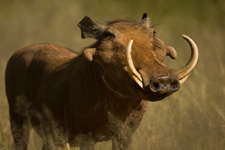
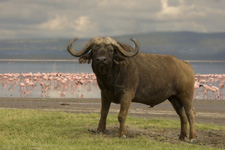
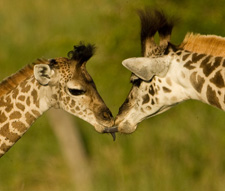
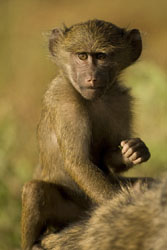
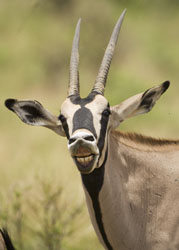
Day 11 - Lower Mara to Mara Triangle
Another brilliantly clear morning and we headed to the kopje rocks
and the lionesses and cubs normally seen there. We quickly spotted
the pride, a lioness baby-sitting her four cubs and the three
older cubs sitting on the far edge of one of the largest rock
formations in the group. Oddly, the cubs ran off the rocks at
our approach, as if they're now a bit vehicle-shy, but soon after
the young cubs rejoined their mother where they noisily struggled
to nurse. At that point we were on the wrong side of the rock
and had to content ourselves with shooting silhouettes of the
scene, while Mary's vehicle had, what I hope was, a sunlit or
more open version. The older cubs stayed in cover and, with the
compromised angle all of us faced, we left rather quickly.
The other three lionesses normally associated with this pride
were feeding upon a wildebeest carcass less than a mile away.
By the time we stopped by one lioness was gnawing on the head,
the only portion of the animal that seemed at all intact. A very
cooperative tawny eagle perched nearby, and we shot full-frame
images of the bird, which prompted a question about the choice
of f-stop. Graham likes to use f9 to give some detail, while Mary
and I frequently shoot wide-open, especially in a scene like this
where the head and feet and front/breast of the bird were all
essentially on the same plane of focus. Gene, who was shooting
a Sigma 300-800, had been shooting at 1/500th at f8-f11, and I
worried that that speed would not be sufficient to stop camera
movement, especially since he must support the back-end of the
camera because of the lens' length. My reasoning is, if it isn't
sharp, depth will be moot, and I'm obsessive about sharpness.
Still, to test out Graham's idea I shot a series of images at
f10 as well, and I'll make a comparison later.
Along the Sand River David and I spotted a distant leopard almost
simultaneously, which was resting on a Sausage tree limb. He immediately
radioed Patrick, and then the others, and we then waited for everyone
to join us before we tried driving closer. Two vehicles were almost
ten minutes away and while we waited the leopard changed branches
several times, demonstrating to me that it wasn't nervous, but
eventually, as more vehicles arrived, it took the prudent course
and slipped down out of the tree. I was very annoyed, because
although everyone saw the leopard no one got a satisfactory shot.
Later, I discussed this with the guides.
In our orientation I stress that 'this is not a zoo,' and that
all of us won't see all the same animals or get all the same shots.
I worried, here, that my lecture to the guide about the miscommunication
about the pangolin had them thinking that everyone needed to see
everything, but doing so would really compromise the shooting.
Do we wait for everyone to gather at a black rhino that is grazing
towards a thicket? A caracal that may bolt at any moment? I posed
these questions rhetorically, and once again stressed to the guides
that this was a photo safari, not a natural history tour, and
that some folks will miss things, but in the long run everyone
will have luck. It did not make sense to sacrifice a potential
great shooting opportunity out of fairness, because as this leopard
illustrated, the net result was that no one benefited, photographically.
As it turned out, the only participant that considered the leopard
the morning's highlight was one of the guys with me, who agreed
that we should have 'gone for it,' since we'd spotted it and wasted
a potentially great shot. I made it clear with the guides that
that was not to happen again, prompting David, my guide, to say
to Mary in an aside that Joe was becoming a hard guy again, like
he used to be. He was wrong there, as he's not the one responsible
for everyone having a successful photographic safari, not a tourist
show.
The rest of the morning went slow, with one cheetah - the group's
first - lying along the roadside. The cheetah may have had mange,
and although Mary thought it looked heavily pregnant it was in
terrible shape and looked down-right ugly for a cheetah. No one
took more than a few shots.
At the Mara River Bridge we paused to shoot some scenics and a
fairly cooperative flat-headed agama lizard male that chased females
and displayed in its amusing push-up posture. I used flash to
fill-in shadows and, at 500mm with an extension tube, it made
my photo highlight of the morning.
PM - Mara Triangle
Cyclone-like winds and a driving rain preceded our game drive,
but the weather cleared and the skies alternated between a faint
sunshine to an overcast. Sky. We started with a fairly cooperative
warthog mother and babies, and I was hoping to get the white whiskers
of the babies in a shot. Those whiskers mimic adult tusks, and
do so so effectively that a few days ago one of our shooters commented
upon the huge tusks of the baby warthogs, mistaking the hairs
for tusks. Unfortunately, these piglets had rather dull, shorter
hairs so the mimicking was not as effective.
The Mara river is very high, so much so that the hippos huddled
in small bays out of the current. Several gaped huge yawns, but
otherwise were rather inactive. We did see a few large crocodiles,
some of which required several images to create a panorama stitch.
A large herd of over 200 zebras moved into the plains near the
river, running back and forth excitedly as if they preparing to
cross. Unfortunately none did, but the prospect of a dramatic,
high-current crossing looms.
Near last year's bat-eared fox den we spotted three, which I took
to be last year's pup and adults, but Mary disagree, thinking
it was last year's immature because of the lack of the distinctive
snaggle-teeth the adults sported. However, one acted young, and
solicited from the adults and raced about, so the jury is out
on this one.
The evening ended with a headlight-flashing vehicle alerting us
that a leopard had been treed by lions. It had an impala kill
in the tree, so it certainly had provisions for the evening. No
shots, with foliage and last minute light preventing all but a
record view of the big, old looking male leopard.
Day 12 - Mara Triangle
AM - Another brilliantly clear morning and we headed down to the
river to check on last night's leopard and the hungry lionesses
by the river. The leopard was gone, but five lionesses bunched
together, looking longingly across the Mara river at the only
game visible, several small herds of Thompson's gazelles. Shortly
afterwards, we got a call saying that a great black-maned lion
was sighted, and we headed to the rocky area known as Bagdad because
it resembles a war zone. The lion was there, lying atop a termite
mound that overlooked the landscape, and, when it deemed to turn
to face us, it presented a wonderful animal-in-habitat shot.
We headed on to look for the cheetahs, and paralleled the white
pyramid markers that define the border of Kenya/Tanzania. Among
the scattered acacias a pair of secretarybirds were building a
nest in an essentially barren landscape of nest-building materials.
The birds would return to the nest with small twigs and long grasses
and thatch, and we wondered if any of it would hold. Still, the
birds were very active and returned multiple times in a 45 minute
period. Later, just .85 miles away, we encountered another secretarybird
pair, so although the grasslands may offer little in terms of
nest building, the trees and the grasslands must provide enough
of the essentials for them to struggle through home-building.
We finally spotted a cheetah, a lone female that looked very pregnant.
She alternated between lying flat and raising her head and shoulders
to look about, and although game was just over the hill, about
200 yards off, it didn't look very promising and we headed back
to camp, arriving around 11:20.
PM - A thunderstorm carpeted the lower Mara far south of our lodge,
in the area we'd game-drove early in the day. Along the river
route, where we traveled, the skies were cloudy but dry. We worked
on a lot of 'fillers,' birds that we bumped into en route, including
black-headed weavers, yellow bishops, immature saddle-billed storks,
and wattled plovers.
Mary radioed that one of the bat-eared foxes was at last year's
den site, and when we arrived one adult was lying outside the
den. While we watched, the fox stood up and looked intense, and
before us a banded mongoose scooted towards the termite mound/den
site. It climbed up, looked over, and before any of us could react
leaped in the air and pounced on the fox! A brief tussle followed
before the mongoose leaped again into the air and ran off. The
fox darted into its hole, and remained there until we drove off.
A cooperative black-headed heron stood poised by a small termite
mound, and we waited quite a while expecting it to stab a small
skink, which often use these smaller mounds for shelter. Eventually
the bird's interest waned as it moved its head about, so we drove
on.
Towards the end of the game-drive we returned to the fox den and,
once again, the adult was sitting outside the hole. We thought
we could hear quiet mewings, as if pups were crying inside, but
neither pups nor another adult emerged, and eventually the adult
walked off, perhaps to forage. I postulated that the ratty-looking
adult, obviously poorly groomed, was recently widowed, and the
pups inside were crying for mother's milk and would starve. Mary's
take was more benign: she believes the mother was inside the den,
nursing, as they often did last year, and the poorly groomed male
is simply getting old.
At 6:15 the sun momentarily broke through a gap in the blue-gray
cloudbank, and a herd of impala glowed in the faint late afternoon
light. We shot wide to include the purple-blue sky, but through
the viewfinder the impalas were not nearly as intensely colored
as in life. We'll see what a RAW converter does to this!
Day 13 - Mara Triangle
AM - Another clear dawn, and in the first light David spotted
a hyena chasing antelope on the flats beside the Mara River. We
raced down in time to see a very spunky topi repeatedly charge
at the hyena, who would turn tail and lope away. Eventually the
hyena wandered off, and the Thompson's gazelles skittering around
the area ran back into the field, no doubt to retrieve a baby
hidden there. Another hyena, a few minutes later, passed close
by another Tommie baby lying flat on the bare soil but missed
seeing or smelling it and passed on.
We located four very tame bat-eared foxes who sat upright in the
morning sun, their ears fanned nicely, but other than some grooming
they were fairly static subjects. Mark and I did ok with birds,
shooting a nice yellow-breasted longclaw and the only wooly-necked
storks I've seen in Kenya this year. They were tolerant and we
made frame-filling shots.
A lioness on a termite mound gave us a momentary thrill when a
topi loped in view and the lionesses focused intently on it before
slipping off the mound and beginning a stalk. Unfortunately the
topi, now hidden by trees, veered sharply away and as the lioness
peered cautiously over a small embankment, the antelope was long
gone.
The highlight of the morning was finally finding the mother black
rhino and calf, browsing low bushes much as it had last trip.
Finding them this time was a greater challenge, as the afternoon
and evening rains have so saturated the black-cotton soil that
entire fields are now flooded. Indeed, the main track leading
from Serena to the Ololooloo gate was covered in places by a rushing,
broad-fronted stream. We tried driving 'downriver' through one
of the tracks, but as we descended the soil grew increasingly
sodden, and we wisely turned back.
No doubt, walking catfish and African lungfish are taking advantage
of this high water to navigate across sodden fields in search
of new breeding sites in flooded luggas. Accordingly, fish-eating
birds are common, and along one stretch of lugga there were at
least six African fish-eagles perched.
At 2PM, as I write this, a powerful storm creeps forward from
the southwest, generating chill, powerful winds. Typical of these
short rainy season thunderstorms, this one is localized and may
miss our lodge, and game-viewing area, completely, or may pass
by our 4PM departure.
PM - The Storm passed, and although a large thunderhead would
soon block the late afternoon sun the weather was clear, and would
remain so. Gary, in getting in to David's vehicle, gave the final
impetus to a cracked weld and the side-board broke off at the
rear attachment. It took nearly a half hour to unbolt the front
threads to remove the piece, where, we were told, the mechanic
needed the vehicle by 5:30 if he was to repair it by tomorrow,
when we leave for our last destination in the Mara. We radioed
ahead to tell the other guides to wait and we would transfer Gary
and Edna to a vehicle. Two were waiting, but Gary and Edna decided
to split, filling the three spots for the two open vehicles. Left
with no alternative but having Mary double-back to double up front
with her, I headed back with David and, at 4:45, finished today's
journal report. Editing, much needed, will follow.
The other vehicles found the mother cheetah with her nearly full-grown
cubs, but the light had failed and shooting was minimal. On the
way back to the lodge three lionesses chased a buffalo, but eventually
gave up. Felix's vehicle got hung up on the chasis in mud and
Gary and Mike tried, unsuccessfully, to push the landrover out,
only freeing the vehicle when Joshua pushed it out with his 'rover.
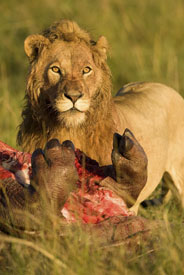 Day
14 - Mara Triangle to Upper Mara
Day
14 - Mara Triangle to Upper Mara
Packing up for our next destination went smoothly, and in the
first light of a crystal clear dawn we spotted three male lions
at a hippo carcass just a few minutes from the lodge. Apparently,
some time during the night the lions caught a sub-adult hippo
and subdued it. Killing holds on hippos are nearly impossible,
and most likely the animal died from shock, and perhaps blood
loss as the lions may have started feeding on its back end as
soon as it collapsed.
Now, the carcass was belly up, with much of its rear end missing,
and a sizeable area between the throat and forelegs. The lions
didn't look stuffed, but they ate desultorily, as one, then another,
fed for a short time before wandering to a nearby ridge to rest.
Two hyenas passed, and whooped, but even an entire clan would
have had trouble with three adult male lions, and these loped
on. Lion males often guard a big kill like this for days, and
faced with the likelihood that nothing else would visit the kill
we moved on.
And quickly found the cheetahs, which had killed an adult Thompson's
gazelle. When we arrived the carcass was half-eaten, and the cats
remained until nothing but the upper neck and head was left. Shortly
after the cats moved on the first Nubian vultures flew in, but
strangely, held back, not coming to the carcass until four white-backed
vultures flew in and began to feed. Then, the Nubians made their
move, hopping in and pouncing on the smaller vultures, and driving
them off.
Over the next hour at least 50 vultures flew in, which was surprising
since not a single bird was visible in the sky while the cheetahs
fed. Two Maribou storks arrived, and a tawny eagle, and, strangest
of all, four warthogs, that marched across the grasslands and
came directly to the kill. They chased a few vultures but were
skittish with our vehicles, and eventually moved off without feeding.
Occasionally, warthogs will feed on the stomach contents at kills,
and we suspect that's what this group was doing.
By 10:30 we headed towards our last destination, stopping en route
at a leopard that another vehicle had spotted. A few vehicles
caught a glimpse, although mine did not, but there was no shooting
and we headed on to camp, finding 6 hungry adult lions along the
way.
By 2PM clouds are again gathering and the skies roll with distant
thunder, so the afternoon may, again, be interesting.
PM - Whatever storm that thundered overhead had passed, and our
skies were clear, with verga and thunderheads far to the south.
By mid-drive, however, those clouds had advanced to once again
create a shroud of clouds, although the sky opened periodically
for nice, warm light.
We headed toward the cheetah with three cubs we'd seen three weeks
previously, as we were told they had made a kill mid-morning and
were nearby. We found them quickly, but they were fat, and buried
in high grass, so we let them go to head toward the river. There
we found 14 lions, 2 males, cubs, and several lionesses, in varying
stages of hunger. The only active lion was the youngest cub, who
was still getting most of its energy from its mother's milk. We
had a bit of luck with the cub playing with one of the males,
but the activity was short lived. The older cubs, the lowest on
the food chain at kills, looked weak and thin - they need a buffalo
kill in the next several days.
We received a radio call that the cheetahs had moved to a termite
mound and we headed back, finding two of the three cubs stretched
out, with uncomfortably taunt, fat bellies, in a hollow atop a
termite mound. Mom cheetah was nearby, and while we watched one
of the cubs came close and was groomed, tongue licking, as we
fired away. Meanwhile, a serval popped up above the tall grasses
onto a termite mound, but the cubs/mother interaction was too
great to leave. Later, quite surprisingly, the serval turned up
less than fifty yards from the cheetahs, again on a termite mound,
methodically slow, stalking some hidden prey. It never got it,
and never pounced, but before we headed to camp we circled the
serval and got some nice front-on stalking views of a very unconcerned
cat. A great afternoon, with 14 lions, 4 cheetahs, and a serval,
and good weather throughout!
Day 15 - Upper Mara
A lone hippo striding purposefully across the wet grasses, rim-lit
from the spill of a brilliant pink dawn, greeted us as soon as
we left the gate. We headed to the cheetahs, hoping they had remained
at their termite mound and indeed they had, moving only a few
dozen feet from the mound of the previous evening.
In the chill of dawn all three cubs huddled tightly against mom,
who, as the light intensified as the sun climbed, repeated groomed
the cubs. After a bit the cubs grew animated and played around
the mother, before nursing and falling asleep. Mary's vehicle,
and mine, stayed, hoping that the cubs would awaken and play but
it looked discouraging, and we headed out. Fortunately, my vehicle
stopped for a yellow-throated longclaw gathering nesting material
along the track, and in the five or ten minutes we watched, the
cheetahs awoke. I looked back and could just see their heads along
the horizon, so we headed back.
Over the next hour or more the cubs, and mother, began a march
across the grasslands as she looked for a new kill. The cubs raced
ahead, tackled one another, and jumped on mom. The cheetah spotted
small herd of Tommies but the big-eared, slender-necked silhouette
of a spotted hyena poking above the grasses kept her from hunting.
Had she made a kill the hyena would have stolen it, so she didn't
waste her time.
By 10:30 the cheetah had settled in the shade of an acacia and
the cubs, having played and wrestled around the tree for nearly
a half hour, finally conked out. We left them, and headed to another
cheetah we had, and had the cheetah mother, spotted earlier. Felix,
Gary, Edna, and Mark had been following her for hours and she
finally made a kill, an impala fawn that, unfortunately, she took
down in brush.
Graham and Gene had had wonderful luck with a martial eagle that,
completely unafraid, made a series of short flights along the
roadside, and Tom and Joan found a rare marsh owl to round out
the morning.
The cat count today was great - 5 cheetah, and 15 lions, the 14
from yesterday and the third male that was missing.
PM - No rain, and only some verga in the distance, and scattered
cumulous clouds that softened the light towards sunset. We went
looking for leopards but without success, and the afternoon, for
everyone, was rather slow. We did shoot the most cooperative goliath
heron I've ever encountered in the Mara, and another hammerkop
that stationed itself above some ripples, waiting for passing
fish. At one point the goliath heron either disturbed, or was
snapped at by, a five foot Nile crocodile, and although the bird
flashed its wings in fright, it quickly recovered. At sunset a
distant shower caught the last light of sunset producing a rainbow
that led downward to a herd of impala.
Day 16 - Upper Mara
Another clear morning and we headed for leopard, aiming toward
the 'cement bridge' where, three days ago, we had a leopard as
headed from the Mara Triangle to the Upper Mara. Gary and Graham
had made a few shots of that leopard, and Mary saw it, but I missed
it entirely. The next day, that same leopard climbed down from
a tree and confronted a large spitting cobra, but eventually backed
off from the snake, so in this encounter, the snake won, and the
leopard, we presume, wasn't injured.
Shortly after crossing one of the Talek feeder streams we spotted
a few topis on the horizon, with a fire-ball sun just minutes
away. We positioned the vehicle and got some nice sunrise shots,
but the animal moved as the sun broke the horizon and the image
was about to look unbalanced. Miraculously, at that moment the
topi walked to our right, directly across the sun, and we got
the shot. As the sun rose higher we did more topi and fireballs,
and I used my LCD monitor more than my viewfinder for framing
and exposure, as the sun, at 10X, was simply too intense.
While we were shooting, David spotted a distant serval, and soon
we headed in that direction, and quickly encountered the cat.
It was a huge, incredibly marked serval, with enormous, very distinct
black spots and well defined neck stripes, one of the handsomest
servals I've seen. Shy at first, the serval eventually rose up
from the grass and proceeded to parallel us. Two black-backed
jackals appeared, following the serval and eventually coming quite
close, so that all three animals fit within the same frame. The
serval sat on its haunches and the jackals moved in, ears out
but unaggressively, until one of the jackals was almost nose-to-nose
with the serval. The cat laid back its ears, but not completely
flat, and hissed or grimaced, but did nothing more. I was expecting
the serval to leap and swat, teaching the jackal a lesson, but
it remained still, and soon the jackals moved off.
Two of our vehicles were at the serval, with one, with Debbie,
Mike, and Gene, clearly doing a lot of shooting. Our's was not,
and so as to not jeopardize the chances of success by working
the serval with two vehicles, we moved on. As it turned out, the
serval grew increasingly tame, hunting quite close to the vehicle
and making several high, spectacular leaps that all of them captured
exceedingly well. I was happy for them, obviously, but felt I
should have been a bit more direct, or less sensitive, or whatever,
and simply said, 'this is a great serval in great light, and we're
going to stay with it,' and followed the instructions I give people
at our pre-departure briefing. Stay with something good!
In retrospect, looking at the glass half-full, our leaving when
we did may have contributed to our covering as much ground as
early as we did, with minimal results. But that resulted in our
getting back into other leopard country early enough to still
be worth searching, and as things turned out, that was quite rewarding.
But more on that later.
Mary's vehicle was at a hyena den with small black cubs, and we
headed in that direction. The cubs were small, still in their
short, dense black coat, and there were three, all competing to
nurse from their mother who, unfortunately, was radio-collared
with a large leather ring and 'beer keg' transmitter below its
throat. That ruined the picture to some extent, but the interaction
with the cubs was phenomenal, as we saw for the first time the
cruel competition between siblings. Hyena mothers have only two
teats and, with three cubs, competition is high. Further, siblings
of the same sex, particularly if they are female, fight and worry
one another until the weaker of the two dies. We clearly saw this
in action, and although we couldn't judge the sexes of the cubs,
it was clear that one screaming, whining little runt was getting
the crap knocked out of her (I'll assume) and was not being allowed
to feed. The shoot was pretty rewarding, despite the collared
female, for the cub interaction but, compromised by the collar
for a variety of shots, we moved on.
We made it to the leopard site without event, and cruised the
area unsuccessfully. Eventually, we headed back towards the Talek,
hoping to encounter one of the three leopards usually there. At
10AM, while David was talking on his cell phone, he spotted a
well-disguised leopard just a few yards into the brush, sitting
in a tree with its tail barely discernible, and its body just
a bit of greater mass in a jumble of limbs. Surprisingly, the
leopard backed up and started down the tree, a completely unexpected
action as Talek leopards are usually extremely tame. Fortunately,
it paused for a few seconds and presented nice in-tree shots,
before it dropped into the brush.
We spotted it again a few minutes later, and then David saw a
second leopard, its mother, following behind. We soon lost the
cats in the brush, but we could hear a growling roar, and we assumed
the leopards were now in a spat at a kill. We looked, without
success, until Felix again spotted one of the cats moving. We
lost them again, and created a watch-line that extended about
a quarter mile, hoping that the leopards would continue moving
and pass into our view.
One did, and Henry spotted it, and the shoot, in truth, was on,
for over the next thirty minutes the mother leopard walked through
a series of clearings, down the game track, and along the brush
line, often within just feet of the vehicle. On multiple occasions
we positioned ourselves far ahead and had the leopard walk down
the game trail directly to our vehicle, before breaking and crossing
feet from the hood or rear. The cat was oblivious to us, and we
hoped as it walked a herd of impalas would be found near the thickets,
but there we didn't have luck. Eventually, just after 11AM, the
cat veered deeper into the brush where there were no tracks and
we lost her, and gave up the chase.
PM - Great weather again, and we headed to the cheetahs again.
We had just arrived in the area, marked by a cluster of a few
vehicles, when the a cheetah popped up and began running down
hill. Although we couldn't see the cubs we assumed, correctly
as it turned out, that it was the mother. She looked as if she
was hunting, despite that we saw no game, and she continued to
jog in the loping manner a cheetah often adopts when it spots
a fawn that she's fairly sure she will catch.
We followed her in parallel, and soon spotted three doe Tommies
prancing down the slope at a slightly veered away angle to the
cheetah's path. At one point we thought they spotted her as they
paused and looked her way, but they didn't, and continued moving
down, and then up a hill. At the lowest point we lost sight of
the gazelles but the cheetah didn't, and began trotting more rapidly.
As the Tommies climbed back into view the cheetah appeared to
be within fifty yards, coming in behind, when she turned on the
speed. From our vantage we could see it all, as she charged uphill
and followed a Tommie as it first veered to our left, then broke
right, uphill, then to our right, before changing course a final
time straight at us, whereupon the cheetah knocked her down.
We, and several other vehicles, were there in seconds, parking
far enough back to give her room to carry the kill in clear view
of everyone, and providing a venue towards her cubs. After a few
carries and drops she stopped and began bird-chirping calls for
her cubs. Almost immediately they appeared on the hill where she
had left them and charged down the hill, where they joined their
mother. More vehicles had arrived as well, and as the kill, cubs,
and mother were fairly obscured by tall grass, we headed out to
look for the three brothers, three male cheetahs we'd seen several
times before.
The light had changed and was rather dull, but we found the brothers
as they marched across the grasslands, pausing for some very rewarding
images on the crest of the hill where we had the choice of shooting
silhouettes, and biasing an exposure towards the sky, or detailed
shots where the sky was overexposed. Everyone did both. Eventually
the cats moved into high grass and we left them, but Mary had
remained around the cheetah kill.
A short time later, as the three brothers scent marked a tree,
the female cheetah spotted the cats along the horizon. She turned
and tensed, and without uttering a sound her cubs keyed in to
her body language and all three cubs jumped to attention as well.
Soon, the three males spotted her and proceeded to move down the
hill towards the carcass, starting in a tight formation of three
but as they neared, fanning out in a purposeful, direct stride
that clearly denoted they were all business. As they broke the
high grass into the short, and grew fully visible, the female
darted off, and after a few seconds of confusion on the cubs'
part, they ran off to join her. One cheetah jogged after her while
the other two males investigated the carcass, and that's when
it grew interesting.
Cheetahs almost never eat carrion or meat they haven't killed
for themselves. We've seen cheetahs walk by extremely fresh gazelle
carcasses, where, after a brief sniff, they passed on by. Everyone
expected this to happen again, but one of the males, after sniffing
the carcass and area carefully, starting eating. Within seconds
the other two joined in, pulling at the carcass and quickly dissembling
it. The fact that cheetahs never eat anything but their own kills
was just countered, and our only explanation for this is that
the cheetahs had seen another cheetah feeding on it and the kill,
and area around it, smelled like cheetah, a female, at that.
Later, we were told, a lone hyena came in and stole whatever was
left from the three cheetahs. There wasn't much to start with,
as the female had had almost an hour to feed before they made
their appearance.
Meanwhile, my vehicle had cruised along the Talek looking for
leopards, without luck, and started back to camp around 6 in the
low light. En route we encountered another, extremely tame serval
that we worked for several minutes. The cat acted like a lion,
simply ignoring the vehicle and sometimes walking right next to
the 'rover. It was a great afternoon.
Day 17 - Upper Mara
We headed back to the cheetahs, figuring that between the males
stealing the mother's kill, and having that, in turn, stolen by
a hyena, the cheetahs would be hungry. We found the mother quickly,
and she presented some nice shots in the early, sweet light, but
eventually moved into heavier grass. One of our vehicles had gone
ahead and found the three brothers again, and they radioed they
were hunting.
When we arrived the males were walking across a vast, very short
grass plain, with topi and Tommies all staring or following closely
behind the cheetahs. In these conditions cheetahs often won't
hunt, as the game is alerted, but … you never know. A BBC
film crew, working, we belive, on a Disney production (according
to their off-road permit display) and the infamous BBC helicopter
with the specially mounted camera for aerial work was there as
well. As we drove up the chopper was in the air following the
cheetahs at a distance. The throbbing wop-wop-wop of the rotors
was distracting, to say the least, and really poisoned the atmosphere
both in sight and in sound. At one point of the three males started
jogging towards the antelope, again in that jog that denotes an
animal testing its prey before breaking into a full-blown chase.
Incredibly, at that moment the helicopter, which we thought could
capture scenes from incredible distances without disturbing their
subjects, gunned their engine and zoomed over the cheetahs, and,
after passing, banked hard to the right and veered off, to park,
stationary, in a new position. That action spooked everything
- the cheetah stopped running but the antelope exploded, and within
mere seconds the game-rich plains were empty. We were really annoyed
and very disappointed with what we'd seen - it simply wasn't right,
and the action clearly disturbed everything.
We stayed a while longer, hoping the cheetahs would resume a hunt,
but with a chopper that periodically lifted off and circled, and
a vehicle-based photographer nearby as well, we lost our stomach
for the whole experience and moved on.
Mary's vehicle, later joined by two others, headed to the Musiara
Marsh and the hippo pool, where they did quite well with hippos
playing with a baby hippo and gaping several times. Tom got some
new birds, too.
PM - Our last afternoon and we headed out along the river looking
for leopards. We didn't have luck, and although we saw 17 giraffe,
a small herd of elephants, 7 lions, and the mother cheetah, no
one shot much. It seemed as if it had all been done and everyone
was content and, short of a leopard or an incredible behavioral
sequence, all were content to simply soak in the Mara.
That evening we had a wonderful bush dinner, the best ever in
terms of ambiance, where we thanked the guides and reviewed final
highlights. Since Mary and I were staying on, and not flying back
to Nairobi, we said our final farewells at the conclusion of the
dinner and of a very successful safari
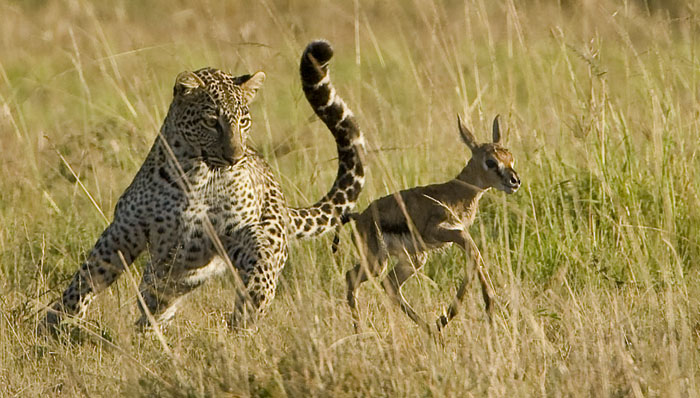
Day 1 - Nairobi to Samburu
Our orientation lasted until about 8 and we left at 9, stopping
enroute at a curio shop and Tree Trout, for lunch, before continuing
on to Samburu, arriving at 6PM. At Tree Trout we had fair success
with Colobus Monkeys, but they were against sky and so there was
contrast. On the way end, much of the group saw a lion, as well
as most of Samburu's endemics, so everyone was very excited.
Day 2 - Samburu
AM - The highlight of the morning for nearly everyone was a spectacular
elephant crossing of the Usaso Nyiro River. Throughout the late
morning small herds of elephants had gathered at the river to
drink, but most of these did not cross. One group displayed wonderfully,
bathing and splashing, and most of these did in fact cross. Late
morning, we heard a canon-like bang, which we were told later
was a shot to drive elephants away from a recently deceased elephant.
It must have worked, for a short time later herds gathered at
the river and proceeded downstream and began to cross. David and
I raced downstream where Mary had already positioned herself,
and we arrived just as the lead elephants reached mid-stream.
Behind them walked, quite literally, a wall of elephants, perhaps
100, maybe 150, and their crossing point was right in front of
our vehicles. At Mary's 'rover, elephants forked, crossing both
in front and behind her, making an exciting first encounter for
Hank and Barb.
PM - Our vehicle did scenics, and Don and Judy did some amazing
shots with her converted IR PS camera. Mary's vehicle worked on
baboons, but was accosted by the Samburu Park Warden who harassed
Felix that we needed a special photography permit because of our
big lenses. That is rubbish, and we were prepared to argue this
at the conclusion of the game drive, but the warden did not show
as he had said he would.
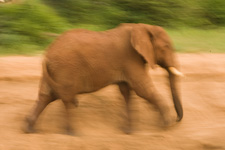 Day
3 - Samburu
Day
3 - Samburu
AM - The rainy season seems over and for the second day straight
the skies were cloudless, promising good light but plenty of heat
later on. We crossed the bridge to the Buffalo Springs side of
the park where, not too far upriver, a large Samburu village has
grown over the years. This morning, quite distressingly, there
was a huge herd of cattle on the Samburu side - our side - grazing
in the early morning light, and Mary saw equally large herds on
the other side, but inside the reserves. No wonder we are not
seeing lions.
At the bridge there was a large troop of baboons, and with telephoto
compression, and a vehicle in the distant background, the image
was impressive, and humorous. We shot some headshots of baboons
as we passed, and the troop in the grass, but the vegetation was
too large to make effective shots.
A good portion of our morning was spent with birds - orange-bellied
parrots, gray-headed kingfishers, white-throated bee-eaters, redheaded
weavers, and crowned cranes, and, towards the end of the game
drive, a large group of reticulated giraffes. These helped Mary's
vehicle to spot an African wild cat which they pointed out by
peering intently in one direction, a good indication that a cat
is about.
PM - A black wall covered the eastern horizon, promising a violent
storm that, aside from generating some strong winds, swept to
the south and missed us. Most of the afternoon the skies were
clear, although scattered clouds masked the sun at times, as they
did, fortunately, as another huge and exciting elephant crossing
occurred at the Usaso Nyiro River. We had been filming birds when
we received the call and raced to the river, passing some nice
subjects and, as we did so, I hoped that we wouldn't be too late.
We weren't, and got there just as dust-kicking elephants stormed
down the bank and into the river. At times as many as three babies
played together, bulls smashed through the water, and cows trumpeted
in alarm - when they flushed a stick-like marabou stork. It was
a great shoot.
Later we continued moving through the riverine forests where I
hoped we'd get some nice gray-headed kingfishers, and indeed we
did. Good vervet monkeys, and a leopard-like savannah monitor
about 15 feet up a tree, lying comfortably, were highlights. Interestingly,
the yellow-billed hornbills that were nesting in a large dead
tree on the last trip apparently have fledged, and in that same
nest hole a pair of orange-bellied parrots are now nesting.
Day 4 - Samburu
AM - Clear skies and an earlier than usual departure from camp,
as we headed downriver to try something new - covering the lower
end of the park early in the morning, rather than working our
way down to it. Tradition can be hard to break with the guides,
and although they know, as do I, that any route, any day, will
be different and can hold magic, it is nonetheless a bit discouraging
to often feel yourself if a rut, doing the same old routine. On
our first day in Samburu, I can always be sure we'll take a certain
track, and do a certain first circuit, without fail. Today, going
downriver, was a nice change, and, as it turned out, a rewarding
one.
The highlight of the morning for my vehicle, with Jack and Doris,
were the owls. We had a Verreaux's eagle owl low on a branch and
in good sunlight, but too many words, too many questions, may
have spooked the bird up to a slightly higher branch. There it
presented great shooting opportunities, with the hanging fruit
of the sausage tree serving as a background.
Later, I spotted a well-camouflaged, but completely in-the-open
pearl-spotted owlet that we ended up filming from two angles.
Eventually we had backed up - why, rather than David driving forward
I don't know - but we got quite close. After Jack got his fill,
I moved into his position, the last spot in the row, and shot
another series of shots. The best of this species, ever.
The savannah monitor we had yesterday evening was back, just emerging
in the slit in the tree trunk he must use as his home. The orange-bellied
parrots we'd seen last evening at the yellow-billed hornbill's
nest must only have been investigating, as the hornbill returned
today, and the nest still looked mudded up.
One cheetah was seen, but was moving through brush and we passed
on it, instead filling that time with an even better gray-headed
kingfisher than yesterday's. Oryx, Grevy's zebra, and Grant's
gazelles, and reticulated giraffes, rounded out the morning …
and I'm missing some!
PM - Clear skies, and we headed to the Buffalo Springs side of
the park. At the bridge, the huge troop of baboons waylaid us
for nearly an half hour, as we followed mothers with babies riding
their backs, watched eyelid-blinking intimidation displays, and,
most notably, a friendly two-some of young baboons we thought
were twins, so close did they follow and play with one another.
Eventually, though, each hopped on to a different female and moved
off.
I was with Terry and Sally, and we worked on birds they'd missed,
and we had fair luck with a gray-headed kingfisher and palmnut
vulture, and excellent luck with a lilac-breasted roller that
was nearly frame-filling, and allowed us to try several different
flash compensations.
The dead elephant from two days ago had been chopped up, but huge,
200 lb sections of meat have been scattered about for scavengers,
and lent a pungent smell of death in the old skeletal forest that
now lines the river.
Day 5 - Samburu to Nakuru
For the first time in years, we headed out of the park via the
Buffalo Springs Gate, thanks to Mary and Henry asking some questions
after observing a vehicle doing just that, yesterday. We would
have made great time to Nakuru, but we stopped for breakfast at
a curio shop where several people shopped, much to the delight
of the guides. We arrived in to Nakuru around 1PM, but by 3:30PM
thunderstorms were covering much of the lake. Several of us elected
to go out, but two vehicles, with Hank, Barb, Natalya, Tom, Terry,
and Sally, headed out, despite the dark skies and intermittent
rain.
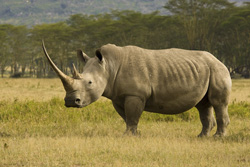 Day
6 - Nakuru
Day
6 - Nakuru
After yesterday's rain, Nakuru was cast in fog and heavy overcast,
but the skies cleared and, until around 11 when cumulous clouds
began to rebuild, the day was bright and sunny. Most of the lesser
flamingos are gone, with a few scattered dozens among thin groups
of greater flamingos that foraged individually along the shoreline.
This prompted the question - were there more greater flamingos
now, than we had seen on the previous trips, or were the numbers
the same but now more noticeable since they weren't lost amongst
the hordes of lesser flamingos? I asked Mary, and she agreed with
me - it was probably the latter - they were always there.
Shooting at the lake was a bit less exciting than normal, although
we did have some wonderful strings of African white pelicans flying
low, and mirrored perfectly in the calm waters. White rhinos were
scarce, and the shots we did were merely 'insurance' shots in
case we didn't have better luck later. Felix, with Hank and Barb,
spotted both a rare aardwolf and a leopard, although Hank only
saw the cat, moments before it disappeared into the brush.
Terry, Sally, and I had great luck with the most cooperative striped
kingfisher I've had in a long time, if not ever, giving us time
to do natural light, flash, and tele-flash shots. David, when
he wasn't talking on his cell phone - to my annoyance, spotted
a pair of spotted hyenas moving along the lake shore. They were
reasonably tame, and soaked in the lake for a bit, but never chased
flamingos as we hoped.
PM - Although a few rain sprinkles hit the lodge around 3PM, the
western skies were clear, and remained so until almost 5:45. We
headed towards Cormorant Point, but the light was so sweet that
we stayed in the forest, and then the open grasslands, looking
for other game. I was with Natalya, who was undergunned for birds,
but Mary headed to the Point where she spent the entire afternoon
shooting birds in the glorious light. We had a great Steppe eagle,
and good baboons, before heading to the Point ourselves to shoot
the birds in the low, late light. Rafael and I shot a dead leopard
tortoise at the lake edge - how it died there is a mystery, and,
after seeing the wonderful belly-view angle, we shot pelicans
from the same position. As we headed back we looked for leopards,
hard, but saw nothing.
Day 7 - Nakuru to Lower Mara
Clear skies, and we headed southwest along the lakeshore and through
the woods, hoping to find more rhino, giraffe, and elephants.
It was a rather slow morning, although Henry's vehicle had a great
encounter with a mother black rhino and baby that, annoyed, chased
a herd of buffalo at least a quarter mile through the forest.
We did have luck with white rhinos, too, four together, lying
near the white pelican morning roost area. There, too, we filmed
a buffalo lying on a sand bar, its reflection mirrored before
it, and cut, periodically, by both greater and lesser flamingos
that walked passed.
David spotted an extremely distant leopard, about 100 yards off,
lying, face away from us, on a slanted log. He registered the
cat after passing and needed to back up, and when he spotted it,
it still took me a few seconds to sweep around with binocs to
finally see it. The cat got up, stretched, and licked, before
settling back down, and everyone had a chance to see it.
The long drive to the Mara was torturous, as usual, but we arrived
in to our lodge at 5:40, early, for a change, and everyone was
glad to be out of the vehicles. David used the cell phone twice.
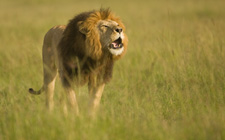
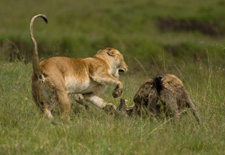
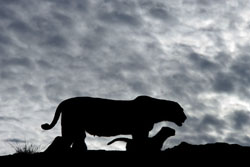
Day 8 - Lower Mara
AM - We headed towards the Kopje rocks, hoping to find the lionesses
and cubs. They were gone, but further north we encountered two
lionesses and four cubs that seemed to be fleeing, jogging along
and constantly looking over their shoulder. We speculated that
there had been some type of bust up with the pride, perhaps a
male lion take-over, and the lionesses were leaving with their
cubs to protect them. Regardless, we couldn't get close to the
lionesses, they just kept moving.
After we left the cats we spotted a pair of reed buck lying atop
a vegetated termite mound and we circled back to film them. They
spooked and bounded off, in the general direction of where the
lionesses were, but we thought nothing of it. Suddenly we saw
a white flash, as if the belly of a reedbuck now shown in the
sun, and we headed to it, wondering if perhaps the lionesses had
attacked.
They had, and in the two minutes or so it took us to reach them
they had killed the reedbuck and chewed out a small hunk of thigh.
As we approached they retreated into the brush, and then started
jogging off. We drove out immediately, hoping that they'd return
to feed on the kill.
Henry got word that more lions were spotted near the main road
and headed there, and radioed us to come as there were several
lionesses and cubs near the road. By the time we got there they
were lying in the brush, but at least some of the pride from the
last two trips were still together, with three small cubs and
at least two larger, older cubs.
I was with Judy and Don, and along with the lions we shot elephant,
a great black-belly bustard calling in display, and a very cooperative
oribi. In total, we had at least 15 lions today.
PM -A great afternoon where we took the time to smell the roses,
and were rewarded for doing so. A very imposing thunderhead covered
the southwest and the mountains beyond Tanzania, but throughout
almost all of the afternoon the skies were clear to the west and
we had great light.
Tom A, Doris, and I worked on several species, including rock
agamas and spotted thick-knees, and excellent portraits of both
Cooke's hartebeest and Topi. Thompson Gazelles were cooperative
as well. From 1.52 miles away - measure via my GPS, we spotted
a male lion with some vans - the give away that something was
there, and we had nice late afternoon light on a pride of around
10. As Mary headed home with Patrick, Barb, and Hank, they encountered
a leopard with two kills in a tree, a small baby warthog and an
older carcass, perhaps a reedbuck. Although the light was marginal,
the leopard was clear and Barb got some clear shots.
Day 9 - Lower Mara
AM - Eight of our people (Doris, Clinta, Don, Judy, Terry, Sally,
Jack, and Rafael) were scheduled to do a balloon ride, so Mary
and I joined them, courtesy of Balloon Safaris, while Tom P, Tom
A, Natalya, Hank, and Barb went on the normal game drive. Although
all three balloon trips this year occurred on clear, sunny days
- sometimes, miraculously, the ONLY clear morning we had while
we were in the Lower Mara, this one was by far the brightest.
One tiny, lone cloud hung on the eastern horizon, and that burned
off quickly.
Our balloon captain spent more time than I'd like virtually skimming
the grass tops, rising to two hundred feet only occasionally,
and only once to five hundred or so, it was still a nice ride.
It is amazing how long it actually takes for the morning sun to
actually generate strong shadows, and we were almost two-thirds
of the way through our trip - perhaps 7:15, before shadows cast
by the few animals we saw actually registered. From the air, however,
we did see elephant, giraffe, a solitary lioness, warthogs, topi,
Thompson's gazelle, buffalo, and running Cooke's Hartebeest, the
only animal I caught with good shadows.
Breakfast was a hoot - champagne flowed freely, conversations
were animated, and, as Clinta said, it was a good break from the
game-drives. Champagne did, indeed, flow, and at the end of the
breakfast we posed Mary on a termite mound, seemingly passed out,
surrounded by about a dozen empty bottles of champagne. She'll
say she wasn't responsible for all of them, but …
The game-drive people headed back to the leopard tree but the
cat never appeared, and the shooters spent the morning filling-in
with birds and antelope. Four vehicles met us at the balloon breakfast,
and we headed out for the remainder of the game-drive, returning
to the leopard tree again. Some time during the morning the leopard
had returned, we were told, but eventually the crowd of vehicles,
and their closeness to the feeding tree, spooked the cat off the
tree. We waited 45 minutes, hoping it would return, but we did
not have luck.
PM - We left on time, but a 'ticket check' from the Nakuru Council
warden delayed our gamedrive by ten minutes, and it cost us. We
were heading to the leopard kill tree, but because of the delay
four minivans were already there. These didn't seem to affect
the leopard, but regardless, the female, very large cat didn't
stay in the tree for long. While it was there, it offered incredible
poses - but just not enough. Three of our other vehicles arrived
just as the leopard slipped down the tree, but instead of disappearing
in the brush it walked through the grasses to a pool where it
drank for nearly two minutes. Then, it disappeared into the brush.
For whatever reason, Henry, driving Mary, Clinta, and Doris, took
the long way to get to the leopard and missed it completely, much
to Mary's annoyance.
We headed out from there, pausing to watch a dung beetle roll
its dung, before encountering four 5 year old male lions that
proceeded to walk across the grasslands. At one point they stalked
towards a very distant buffalo, and our vehicle, with Jack and
Rafael, was right in the line-of-sight, giving us incredible stalking
shots. Earlier, we diverted from the lions for a short time to
find, and film playing, two lionesses and two cubs.
As the sun dropped one of the lions laid alertly on a termite
mound, and we positioned ourselves to shoot it against a leaden,
stormy northwestern sky. To fill in the contrast I used flash,
and I was extremely excited about the results. Later, we repositioned
ourselves to set the lion against the sunset, but the disparity
in exposures was too great and I needed to do an exposure composite.
As the end hour neared we raced to the leopard tree (this time
Henry was first) and we had a few minutes with the leopard, which
had returned to the tree, relocated the warthog to a much higher
branch, and laid sprawled on a low limb. Using flash, I bracketed
my aperture to create a middle tone background and one much darker,
almost night-like. It was past 6:30 when we left the leopard,
but returned back without incident.
Day 10 - Lower Mara
AM - We headed to the leopard tree again at first light, and this
time the leopard was there, feeding high in the tree on the warthog
carcass. We waited, while slowly the dawn sunshine crept down
the distant hillsides, but the leopard grabbed the carcass and
moved down from the tree just as the sun hit the tree. She paused
at the bottom almost completely in the open, and then, with warthog
in her jaws, proceeded to walk nearly 2/3rds of a mile through
the brush before carrying it up another tree on the edge of a
hillside and thick croton bushes. After depositing the carcass
she turned around and groomed, no doubt removing some of the water
from her paws after traveling through the wet grasses.
She climbed back down and disappeared - although at the end of
our game drive I returned to see if she brought cubs back. She
had not, but was sitting at the base of the tree, periodically
gazing up at her kill.
We headed on towards the lions, hoping they'd be making a buffalo
kill, but three of the four males were sacked out, until the fourth
walked some distance and joined them, whereupon all headed into
the brush. A huge herd of buffalo have been in sight for days,
but the lions apparently aren't desperate enough to try tackling
any of them in the herd.
We continued, and Natalya and Doris shot gnu (the first we've
seen this trip in the Mara), topi, hartebeest, and ostrich. Eventually
we reached the oasis, where we found a dead elephant that lions
had been feeding upon for several days. Now, the question arises
- why didn't the guides share that info with us, and why, yesterday,
when those not doing the balloon trip didn't go there, rather
than suffer through an incredibly slow morning drive. This is
vexing since I've spoken to the drivers about this.
At the elephant kill we had an extremely cooperative tawny eagle
that took off at our approach, but settled on an adjacent branch
that was even better than the first. Vultures flew in to the elephant
carcass - they had been perched, either sated or cautious, but
these were eventually driven off by a 4 year old male that rushed
out of nowhere to chase the vultures.
Mary's vehicle had a great day, too, and she shot over 9 gigs
- a far cry from yesterday's gameless morning gamedrive.
PM - Great skies, and we headed to the 'hammerkop' area which
has proved rather slow lately, and today was no exception. The
group had three servals, with Mary having a very cooperative one
that leaped just as they were about to set up, and did not do
so again.
Four sleeping lions presented a fairly good 'tourist' shot with
our vans in the background, and later they went after a hippo
that is trapped by the lions in a lugga. No shots, however.
We stopped at the bat-eared fox den which, to our surprise, has
nearly three-quarter grown pups. The grass was high around the
den and the foxes were in the thick of it, rather than on the
flat bare entrance, so we didn't stay long, as we planned to return
later. When we did, at 5:50, the foxes were out, with one pup
hovering at the entrance. Eventually he hopped over to the female
(I presume) in the high grasses, while its nest mates made little,
high-pitched whistling squeaks. We waited until 6:20, but the
pups never got active, and the male wandered off to rest in high
grasses some distance from the road.
Day 11 - Lower Mara to Mara Triangle
We headed back to the Sopa area, hoping to find the lions hunting.
A beautiful pink sky caught the first predawn light, covering
all but the eastern horizon. In the distance, towering thunderheads
glowed a soft pink across the northwestern horizon. As expected,
the leopard tree was empty, as was the tree where the leopard
had carried the remaining half of the warthog carcass. A brown
snake eagle atop a busy tree was cooperative, but as the sun rose
it passed behind the vault of clouds and the light died to mud.
We continued on.
At the elephant carcass we were told that hyenas had been present
earlier in the morning, and must have been present throughout
the night as the carcass - nearly completely intact, save for
a gnawed hind leg and an opening at the anus to the body cavity
- was now completely stripped up to the shoulder blades, at least
from what I could see. Vultures were everywhere, covering most
of the carcass, but between bodies I could see the pelvic girdle
and long backbone before it disappeared at the shoulders, and
beneath the masses of birds.
Joshua called about a leopard, and with the typical confusion
of communication we weren't sure whether or not to retrace our
drive and check it out. Mary was heading that way as well, so
we drove, too, arriving just as a very cooperative leopard climbed
atop a grass-covered termite mound where it paused in the shade
of a bush. From there it headed back into the tall grasses, eventually
disappearing into a lugga.
We took the back route back to the kopjes, passing a large dead
tree with a cavity where two ground hornbills flew in to perch,
before one disappeared into the cavity. The other, carrying a
frog and some insects, remained outside. The light was bad and
we moved on, but three more hornbills later flew in to the nest
- probably last year's clutch now assisting with the raising of
the new brood. They do so to help insure genetic success in raising
their siblings, as numbers help to defend these very rare and
precious nesting cavities.
We found one very hungry, nursing lioness at the kopjes, looking
intently at two giraffes in the distance. Without help, a giraffe
is virtually impossible for a lioness to kill, and, to make matters
worse, a giraffe's eyesight making spotting a hunting lioness
easy, and the giraffe's alerted posture telegraphs the presence
of a lion to all other potential prey. In this case, however,
there was no prey in sight, and we doubt if her cubs - which we've
seen since we arrived here in October, will survive.
In all our group saw 17 lions as we headed to our next destination
in the Mara Triangle, where we arrived without too much activity
around 12:30PM.
PM - We headed to the Mara River for the usual first-afternoon
stop for crocodiles, hippos, and, hopefully, the tame banded mongooses
that are often found here. Judy, Don, and I had spent about 30
minutes with a well-lit hippo pod, waiting for the hippos to yawn
when two hippos glided together and a brief but exciting gaping
fight occurred. It didn't last long, but there were large, toothy
mouths, but stupidly I had my camera on single-shot because I'd
earlier been shooting flash of a martial eagle and had not changed
the settings after the morning game drive.
We had just decided to pack up and move out when we received a
call that zebras were crossing and a crocodile had snatched one.
We raced to the crossing - just a quarter mile up river, and got
there in time to see a zebra break free and scamper up the bank.
Then we noticed the one that was caught, as it tried jerking itself
free, raising its head high, but ultimately getting bobbed under
and, in a few minutes, sunk and drowned. Hank and Barb, and Clinta,
in Joshua's vehicle, actually caught the lunge - I saw Hank's
shots later and he has a shot as the croc is in mid-air lunging
at the zebra.
We fired away, but the drama was in real-time, not in the shots,
as the zebra simply looks as if it were splashing. Eventually
all calmed down and we found there were two crocs with two dead
zebras, both with their heads near our shoreline. Eventually one
of the crocs moved mid-stream and lost its carcass, which flowed
downriver but eventually lodged on rocks where, at the end of
the day, we shot three crocs tearing it and getting small mouthfuls.
The other carcass was pushed upstream by a large croc which eventually
settled at the first set of rapids and here it rolled and jabbed
at the soft underbelly, eventually dismembering the carcass. Another
croc, and several large fish, appeared and worked the carcass
over, until it seemed all way eaten. At that point we moved downriver
to the second carcass, but Mary stayed behind and as what was
left floated to the surface, a large croc lifted its head and
shook the carcass to pieces, making some very dramatic shots.
In the last light, golden through a clear sky, several hippos
yawned widely while facing their cameras, making for some nice
hippo shots as well.
Day 12 - Mara Triangle
We got out to an early start but within minutes, near the airstrip,
we stopped for the hyena den where two adults and one baby lay
about the numerous entrances. The baby was the same lone individual
we saw on the last trip, but three weeks later it has lost its
black coat and now sports a vivid spotted pattern - a miniature
of the adult, and not as cute as the younger version.
David had a bad nose bleed from the flu he has - he's been hacking
horribly for days, as has several participants, and we headed
back to the lodge so that he could see the doctor and get the
blood stopped. Twenty minutes later, he returned to the car, gauze
and a large bandaid covering his nose.
In the meantime, the group found a new set of cheetahs, a mother
with 4 cubs about 9 months old, far in the southwest of the Triangle,
within an hundred yards of the Tanzanian border. Luckily, they
were not doing much, so the twenty minutes required getting there
wasn't disastrous.
A herd of both Thompson's gazelles and topi grazed nearby, and
the topi eventually spotted the cubs when, bored with the inaction
they started to play. While they did so the mother moved out,
sitting at attention and watching. Eventually she started her
purposeful walk, then jog, as she spotted a baby Tommie. The chase
was quick but a bit distant, but the take-down was clearly within
sight.
Cubs of that age are usually trained, and the mother will carry
and then release her catch to allow the babies to chase and tackle,
thus learning valuable hunting skills. This mom was hungry and
carried the baby much longer than I expected, and when she dropped
it into some long grasses it squirmed, but the babies hopped on
too quickly and the mother resumed her stranglehold and quickly
killed the fawn.
Eating went uneventfully, and afterwards the bloodied cubs were
groomed by mom and each other before walking off. At a seep they
drank, and while the mother looked for more game northward, the
cubs began to run and play. Too soon the mother headed south again,
towards the only game visible, herds scattered on the Tanzanian
side of the border.
PM - We headed upriver, following the report of the black rhino
and calf. En route, we stopped along the Mara where we paused
for more hippo shooting, but none displayed and we moved on. Five
lions lulled in bushes close to the river; had they been here
yesterday I'm sure a zebra would have been taken during that confusing
crocodile kill.
Western storm clouds tanked the afternoon light and under rather
dim conditions Hank spotted the rhino in a gap between thick bush.
We moved in and both mother and calf paused alertly before shuffling
off, quickly disappearing in the bush. As we headed back to the
lodge Hank spotted a lioness in the grass - I was looking the
opposite way, searching for a malachite kingfisher to show Barb!
- and nearby a buck waterbuck stood at attention. We moved passed
to give the waterbuck room to travel forward, and hopefully passed
the lioness. It did, but the lioness did nothing, and actually
showed disinterest as it twirled its ears and looked about, albeit
from a lying down or crouched position.
Mary and her crew did well with approximately 100 elephants strung
along the grasslands below the escarpment. Two males fought, and
when finished, trashed a tree. Barb saw a saddle-billed stork,
which was a thrill, since that bird graces the cover the bird
book she is using.
Day 13 - Mara Triangle
We headed down to the river where we'd seen several hungry lions
last evening, but they were gone, and the game looked relaxed.
At the bat-eared fox den an adult and four pups lingered, with
one pup huddled against the adult while the other three came and
went, diving into the den and hoping back out again. A few high
grass stems made the shooting a bit troublesome, and with all
our vehicles there it was tough to try a different angle, so all
of us moved on.
Mary had stopped at the hyena den where four new, black pups were
visible. Later, her vehicle found the big black-maned lion, a
great, smooth-looking specimen by the side of the road. He turned
several times and we drove about, trying back, side, and front
lighting. Eventually he got up and moved towards the shade of
a tree. We raced ahead to catch some head-on shots but mid-way
he paused and did a magnificent series of roars, facing our lenses.
We headed on to look for the black rhino, but we were unsuccessful
today. En route we shot two new born Tommie babies, with one putting
on a nice show as its mother licked and groomed it rather close
to our vehicles, before she and the baby bounded off with surprising
adeptness and speed. Crowned cranes went through a brief courtship
dance of wild hops and flared wings, but otherwise the morning
was a bit slow, for us.
At 11:20 Mary's vehicle, with Henry driving, came across a lioness
hunting a warthog. She caught it, and they would have had a great
struggle sequence but a young male raced in and knocked it down
and began to feed, even as the lioness maintained her chokehold.
David used the cell phone to call his wife and son to order an
African shirt for Jack, but made another call that was unrelated
to this.
PM - Several people hadn't had much luck with hippos or black
rhinos, so we headed to the river and then on to the area where
we spotted the rhino yesterday. The hippos, this early, did little
more than soak, so after some record shots we headed out. All
of the vehicles covered the rhino area, but we were not successful.
On the way back we stopped for courting crown cranes that stopped
displaying when we arrived, but did oblige by drinking at a small
pool quite close to our vehicle. Afterwards we headed to the bat-eared
fox den where, tonight, the pups were out and much less skittish,
although only one adult was present. Our working distance was
further than I'd like, and after getting some shots everyone headed
to the river for a final crack at hippos, where we were fairly
successful with some yawns.
Day 14 - Mara Triangle to Upper Mara
We packed quickly and headed out, giving up on our quest for another
bout with the black rhino and instead hoping to find cheetahs.
We were quite successful.
Our first stop was at the airfield hyena den where all four black
pups were playing at one female at the den. It appeared as if
they were nursing, too, but much of the action occurred slightly
below ground level. At any rate, the cubs played 'nice,' with
none of the harassment we'd seen at the den in the Upper Mara
on our last trip. Eventually the pups settled down to nurse -
below ground level, and we moved on.
On the way towards the Tanzanian border we encountered a nicely
lit pair of crowned cranes that began another courtship dance,
as another pair did last evening. The female did little, but the
male bobbed and hopped, eventually leaping into the air with spread
wings. The display didn't last long before both started preening
and feeding, and a radio call beckoned us to the cheetahs.
Both mother cheetahs were spotted, within sight of each other
and close to the border. The mother with the four young cubs wandered
into Tanzania while the cheetah with two full-grown cubs, the
ones we saw last trip, headed eastward. From a distance we watched
one of the young cheetahs chase a black-backed jackal nearly a
quarter mile, but we couldn't tell if it knocked it down or just
gave up.
Later, the cubs encountered a bat-eared fox pair as they raced
to their termite mound for safety. From our vantage it looked
as if the foxes were running straight to the cheetahs, which responded
by cornering one and slapping it about until it ducked into a
hole. The other kept running, with another cheetah cub in pursuit,
and again appeared to be wrestling with it. The fox had its tail
fluffed out and curled over its back, but not in a complete threat
display as this one was fighting for its life. We guessed that
it snarled, flashed teeth, and attempted to bite, and that intimidating
display kept the cheetah from making any further moves after slapping
it down.
Afterwards the cheetahs settled on a termite mound where mom stalked
a pair of Tommies, but the hunt was blown as the cubs walked towards
her, plainly visible to the gazelles. They again settled in the
grasses and mounds, and with no further prey in sight we headed
on to the Upper Mara, arriving around 11:50AM.
At the crown crane, David used the cell phone for about 5 minutes,
with a woman - Regina? - and overtalked the radio. I'm not sure
if Henry was trying to inform him about the cheetah during that
entire time but afterwards David, when off the phone, said they
had cheetahs. Whether or not he heard that during, or just after
the phone call, I don't know, but I worried that he may have missed
the first communication because of his talking.
PM - We headed out for the cheetah and three cubs we've been following
since we've arrived in Kenya 8 weeks ago. Despite the harassment
from the BBC helicopter, the cubs have survived. After watching
from a distance we moved in as they started walking and did a
superb family portrait when the cubs and mom perched atop a termite
mound in great afternoon light. Afterwards they settled behind
another termite mound that did not offer shots, and after watching
for an hour, and as it was after 6, we headed towards camp, hoping
to see serval. Indeed, Jack spotted one, and it was cooperative,
and everyone finally saw, and shot, a nice serval.
At the stinky water bridge a hippo daintily tiptoed across the
rocks and as we shot it we received a call that Sally had spotted
a leopard. We got there in time to see it disappear into the bush,
but followed, and all of us got some shots. It ended up perched
above the stinky waters, sitting, then lying down, on a rock overlooking
the river. A three spotted cat afternoon, and a four cat day!
Day 15 - Upper Mara
We headed along the Talek, hoping to encounter a large pride of
lions that were recently spotted. Terry, glassing with binocs,
spotted cats, and although they looked like cheetahs from our
distant view, they were in the area where the lions were reported.
They were cheetahs - a female with three cubs just a bit older
than the ones we had at Rhino Ridge yesterday afternoon.
These were well-fed and the cubs a bit shy, but in the pre-7AM
light we did some nice low angle, front and back lit, shots of
cubs and mother. While we were shooting vervet monkeys started
calling, and we presume they had a leopard, but the vehicles we
saw were on the opposite side of the river and no one saw the
cat.
When the cheetah and cubs settled down under a bush we headed
to the Ridge to see if the other cheetah was hunting. We found
her quickly, and although she moved a lot, a hyena kept shadowing
her and inhibited her from hunting. Worse, the BBC was there,
so for much of the time we hung back, giving telescope-views at
best.
At 11AM I called it and we headed back towards camp. En route
to the second cheetah several people had great luck with fighting
buffao and fighting male giraffes, that ended the bout with some
male dominance mounting - RuRu, as we are calling it.
David used his cell phone once, and it rang loudly one other time.
PM - We headed out at 4 under a hot, basically clear sky, with
the heat pounding and the sun intense, making both Mary and I
think back on the cloudy, cool game drives of just a few weeks
ago. We headed out for leopard, spotted earlier today on the other
side of the Talek, and spent much of the first hour simply driving
about, looking. Eventually we came across several vehicles that
had located the leopard, at this point stalking ever so slowly
in an absolute exquisite demonstration of stealth. She missed
the dik-dik she was hunting but later, as we followed her through
the brush, she did a quick capture of an African hare, and consumed
it in front of us.
I was with Natalya, who was experiencing some frustration as David
tried positioning us for the best shot, but doing so faster than
N could react. We did have several opportunities before we finally
lost the cat in the croton bushes, but we skirted these, hoping
the cat might reappear in a clearing. It was passed 6 as we staked
out a clearing, but after 10 minutes, with no leopard, we moved
further into the clearing where we discovered her atop a termite
mound, in the late evening sunset, completely exposed. It was
a dream shot, and Terry and Sally's vehicle got in before the
cat slipped off the mound - after posing for us for an easy 5
minutes.
Mary's vehicle and others had left earlier, and found the three
brother cheetahs, and another vehicle had a serval, making it
a three spotted cat afternoon. Others did quite well with baby
hippos and bee-eaters, so the afternoon shoot was a huge success.
Day 16 - Upper Mara
We headed towards the far northern end of the reserve, towards
Musiara Marsh and the Lettuce Pond by the Governor's Camp airstrip.
En route, we hoped to spot the three brothers (cheetahs), before
concentrating on the hippos at the pond.
En route, Barb, Hank, and I had the most cooperative kori bustard
in full display I've ever had in the Mara, with the adult cocking
its white tail back and, at least as we approached, having a balloon-like
inflation of its throat, creating a white beacon I knew as a kori
fro quite a distance.
The hippo pool was great, with a pod close to the shoreline for
a short time where they wore their lettuce hats, but the real
action came at the back pond where a male continually circled
a female guarding either a younger female or a male that the aggressor
male was trying to harm. The defending female continuously chomped
her jaws while the male feinted or charged, and periodically displayed
its jaws widely. I thought it was two males fighting, but discussion
at lunch revealed the more common sense analysis.
A group of elephants marched in and drank and mudbathed, making
nice shots as well.
While we were at the ponds Henry radioed that three lionesses
were stalking zebras, but they were too far away for us to get
there in time, and, as it turned out, the hunt lasted only ten
minutes or so. Henry hung back, in deference to a BBC crew filming,
so the initial take-down was too far away for shots. When we arrived,
the three lionesses were feeding, but eventually they left the
kill due to the intense sun. We headed on to the cheetah mother
with three cubs, where another BBC crew was filming.
We watched those cheetahs for a short time, far too far away for
shots, and we were about to pack it in for the morning when Patrick
heard hyena whoops, meaning the zebra kill had been discovered.
We raced to the scene.
When we got there the lionesses where surrounded on three sides
by hyenas, which moved closer and closer. Eventually, one of the
lionesses charged, actually catching the hyena in a nearby pond,
but after some mauling the hyena squirted free. That lioness,
or perhaps another, was on the far side of the pond when she was
surrounded by almost 10 hyenas, who mobbed her and tried biting
her back. Eventually she broke free.
The hyenas were closing in on the kill again, where one lioness
sat wolfing down meat after driving two hyenas away, when a rival
clan appeared over the hill and charged the scene. Our hyenas
left the lions to confront and ultimately chase off those interlopers,
and for several minutes there was chases, yelps, howls, a real
uproar.
Eventually the intruders were driven off and the hyenas returned
to the lionesses, but it seemed they were distracted by the distant
hyenas and had lost their steam. At that point, a 5 year old male
lion appeared and galloped forward, not chasing the hyenas but,
with a roaring growl, driving off the three lionesses from the
kill. They moved off to the shade and the hyenas, who had scattered
and retreated at his approach, gradually wandered off. We waited
about 45 minutes to see if they'd regroup, but the few remaining
walked off so we headed for a late - 2:45 - lunch.
PM - We headed up the Talek, content to have a slow afternoon
of birds and other wildlife, but that plan quickly changed as
we had a radio call about a serval eating a rabbit. The shots
were minimal because of the high grass but the cat was relatively
mellow.
The other cheetah with three cubs was spotted just a short distance
further, and tonight she was out in the open on very short grass
with one very relaxed cub lying nearby. Later, the other two cubs
warmed up and joined mom, playing with her and then running about
and wrestling.
We had a bit of a tense late game drive as a mother lion with
two cubs walked towards the cheetahs, stopping about a quarter
mile away. The cubs spotted her but basically ignored her, after
a few minutes of frozen staring, but the mother was oblivious,
turned the wrong way or sleeping, or, when she was looking in
the right direction, the lioness was motionless. Fortunately the
lion cubs walked off into the brush and a short time later, as
the sun was close to setting, the lioness joined them.
Day 17 - Upper Mara
With so many encounter with cats, yesterday's lion/hyena war in
the morning, the cheetah family in the afternoon, indeed, we had
28 lions, 11 cheetahs, and 4 servals in total for the day, we
were not looking for cats this morning. Instead, it was to be
a day to 'smell the roses,' as we worked a new area south of the
Talek looking for birds, antelope, and whatever else presented
itself for good photos.
Rafael, Tom P., and I had found a rather cooperative Thompson's
gazelle doe with a fawn that looked to be one day old. Its legs
were upright and it didn't teeter, but it was small, tiny, really,
and the two posed nicely. We stayed with them quite a while, working
closer each time they moved out of range, finally ending with
a nice family shot. They wandered off into a pocket between two
extensions of the Talek forest and we were about to put our gear
down and leave when a cat rushed out and gave chase.
It happened fast, and for a moment I thought it was a cheetah
bounding across, but before it snatched the baby I knew it was
a leopard and, by then, I had my camera up, just in time to get
a distant shot of it at the moment of the kill - a very poor shot.
Seconds later it grabbed the baby in its jaws and bounded towards
the forest edge where it had launched itself, and disappeared.
We were stunned and elated, and I high-fived David. Seconds later,
the leopard reappeared with the baby in its jaws. The leopard,
a young female, released the baby which immediately darted into
the open, towards where its mother still stood. The leopard was
right behind, and caught it again. Over the next ten minutes,
as all of our vehicles zoomed in to see this, the leopard repeated
this performance, going into the woods, returning, and chasing
the baby - four times in all.
Finally, the leopard left the open field, but she continued her
play in the croton thicket, where we had brief glimpses and, several
times, thought she had killed the baby and was feeding. Eventually,
and without warning, she dashed up a tree where she continued
to play with the fawn, plucking fur, chewing, and, once as the
fawn dropped from the limb, snatching it in mid-air with her pawn
in a lightning fast move. Sadly, it took the baby a long time
to die, and shortly afterwards the leopard dropped from the tree,
baby in its jaws, and we headed to a breakfast tree rendezvous.
There Joshua performed a demonstration of the crowned crane dance,
and all the women participated as he courted. Several of us videoed
it, and it was a fun break after an incredibly intense morning.
From there, three vehicles headed to a Maasai village where Henry
would act as guide, Mary headed back to camp with Clinta, and
we continued our drive. We headed back to the leopard, too, and
found her beneath her tree where she consumed the final bit of
fawn - two legs that she chewed on but totally engulfed, swallowing
them like a marabou stork. I got a nice front head shot for id
purposes.
Next, we worked with a wonderful, 'nesting' baby giraffe and two
adults, which we spent a lot of time with getting a background
that was perfect. As we headed back to camp we checked both hyena
dens - now empty and apparently abandoned, and stopped for the
most cooperative band of 30 or so banded mongooses we've had outside
of the Mara Triangle.
PM - We headed across the Stinky Waters towards Paradise, following
the Mara River for a time below the Serena Lodge. It was a fairly
slow afternoon, but a group of crowned cranes performed their
dance, creating the highlight. Coming around Rhino Ridge we passed
several large termite mounds similar to those on the Talek where
our leopard hangs out, and I suspect it hunts here often as well.
Day 18 - Upper Mara
AM - We headed back towards Musiara Marsh to look for lions, not
knowing, and not being told, that lions had killed a buffalo on
the Observation Hill area, and a leopard had been spotted there.
Several of our vehicles had great luck with lions, seeing 17,
including 5 that drank together, in the open, at a small waterhole.
We had another, perhaps our best, kori bustard display that allowed
us to get quite close. The marsh was slow, but we all gathered
there for breakfast before heading south to camp. En route we
had a great Masai giraffe sparring battle, and two baby giraffes
so close in age we thought they were twins. While we watched,
impalas and baboons started screaming alarm barks, and the giraffes
exploded. Shortly after, and some distance from the giraffes,
two lionesses appeared, and they trotted after the giraffes, which
just kept running. Seeing the hopelessness of the chase, the lions
laid down and rolled over.
PM - Mary, Rafael, and I went out on our last game drive, where
we met 11 lions from the morning's encounter. Storms were gathering
in the west and the light was marginal, and the cats relatively
inactive. Two lionesses saw and stalked a family of warthogs that
dashed for cover at a burrow, but they stayed inside and the lions
eventually lost interest. We had to close our hatches for rain,
and needing to pack, empty beanbags, and get our group portfolio
slide show together, we headed back to camp early, arriving at
6PM.
We were all ready to come in, I believe, as the safari was spectacular
and satisfying. That evening, to mark the end of our time in Kenya,
the camp staff made a great bonfire where we shared times and
jokes, winding up the evening at 11PM. The trip was over -- a
great one, and we were now ready to go home.